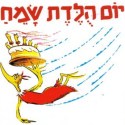|
March 2011 Updates
Happy Birthday Judah!

03.31.11 (II Adar 25, 5771) "Sunrise, sunset... swiftly fly the years." Today is Judah's second birthday... It's almost hard to believe that two years have passed since the LORD blessed our family with this great treasure. Yom huledet same'ach, beni!
HAPPY BIRTHDAY JUDAH!
Words and Healing...
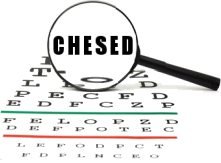
[ The following is related to this week's Torah reading (Tazria). Please read the Torah portion to "find your place" here. ]
03.31.11 (II Adar 25, 5771) Just as a body can become sick with illness, so can a soul: "I said, 'O LORD, be gracious to me; heal my soul (רְפָאָה נַפְשִׁי), for I have sinned against you!'" (Psalm 41:4). Likewise we understand that fear profoundly affects the way the brain processes images and messages. Fear colors the way we see and hear things. And since the mind and body are intricately interconnected, fear is often the root cause of many physiological problems such as heart disease, high blood pressure, clinical depression, and other ailments. Left unchecked, fear can be deadly. Note the connection between fear, lashon hara (evil thoughts/words), and sickness (tzara'at), which are themes of this week's Torah portion...
The targum Onkelos states that God breathed into Adam the ability to think and to speak. In other words, thought and speech are two primary characteristics of the image (tzelem) and likeness (demut) of God. Since our use of words is directly linked to the "breath of God" within us, lashon hara (לָשׁוֹן הָרָה) defaces God's image within us.... Using words to inflict pain therefore perverts the image of God, since God created man to use language to "build up" others in love. This is part of the reason the metzora (i.e., one afflicted with tzara'at) was regarded as "dead" and in need of rebirth.
Lashon hara is really a symptom of the "evil eye" (ayin hara). "Evil comes to one who searches (דָּרַשׁ) for it" (Prov. 11:27). We must train ourselves to use the "good eye" (ayin tovah) and extend kaf zechut - the "hand of merit" to others. Genuine faith is optimistic and involves hakarat tovah, that is, recognizing the good in others and in life's circumstances. Gam zu l'tovah: "This too is for the good" (Rom. 8:28). The Midrash states that God afflicted houses with tzara'at so that treasure hidden within the walls would be discovered. The good eye finds "hidden treasure" in every person and experience.
King David said (Psalm 35:13): "May what I prayed for happen to me!" (literally, tefillati al-cheki tashuv - "may it return upon my own breast"). Some of our prayers are conscious words spoken to God, whereas others are unconscious expressions of our inner heart attitudes. When we harbor indifference, ill will, or unforgiveness toward others, we are only hurting ourselves. It is very sobering to realize that our thoughts are essentially prayers being offered up to God... When we seek the good of others we find God's favor, healing and life. Yeshua spoke of "good and evil treasures of the heart" that produce actions that are expressed in our words (Luke 6:45). A midrash states that if someone speaks well of another, the angels above will then speak well of him before the Holy One.
In light of the enigma of "spiritual impurity" (i.e., tumah) and its ultimate expression revealed in the corruption of death, it is all the more telling that we should heed the cry of the Spirit: "Choose Life!" (Deut. 30:19). Sin is a type of "spiritual suicide" that seduces us to exchange eternal good for the petty and trivial. The nachash (serpent) in the garden of Eden was the first to speak lashon hara. He slandered God and lied to Eve about how to discern between good and evil. He is a murderer and the father of lies. Resist his wiles with the truth of God...
May it please the LORD to help each of us be entirely mindful of the power and sanctity of our words... May it please Him to help us use our words for the purpose of strengthening and upbuilding (οἰκοδομὴν) one another (Eph. 4:29). May God help us take every thought "captive" to the obedience of the Messiah, thereby enabling us to always behold and express the truth of God's unfailing love.
 |
New "Table Talk" for Tazria
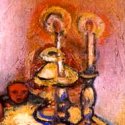
[ The following is related to this week's Torah reading (Tazria). Please read the Torah portion to "find your place" here. ]
03.30.11 (II Adar 24, 5771) Today I wrote a Shabbat "Table Talk" for this week's Torah portion (Tazria), which is the fourth portion of the Book of Leviticus. Like other Table Talk guides, I first provide a brief synopsis of the reading and then ask some provocative discussion questions. For instance, one question we explore is why childbirth makes a mother "unclean," and why her "period of impurity" is twice as long when she bears a girl rather than a boy. Another question concerns how we are to understand why a mother was required to offer a sacrifice for sin (chatat) after the birth of her child. I hope you find it helpful, chaverim. You can download the page here.
Note: My son Judah turns two years old tomorrow... Please pray for him (and for his parents). He is a "spirited" child which means he needs a lot more interaction from us all the time. Thank you.
 |
Universalism and Legalism
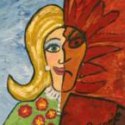
03.29.11 (II Adar 23, 5771) Both "Christian" universalism and legalism are scandalized by the message of the Gospel... Universalism teaches that God's love is categorically unconditional, and therefore (in the end) everyone without qualification will be saved, whereas legalism teaches that our acceptance before God is conditional, and therefore (in the end) only the obedient (i.e., the worthy) will be saved. Universalism stresses the "all-inclusive" nature of God's redemptive plan, whereas legalism stresses meritorious obedience as the means of finding acceptance before God. Ironically, both universalism and legalism appeal to the idea that people are justified by their deeds. In the case of the legalist, this is obvious enough, but in the case of the universalist, it is assumed that God would never ultimately condemn a person who was morally virtuous, even if that person plainly rejected the teaching and message of Yeshua... In other words, the very motive of the universalist to ascribe God's salvation to all people is centered on the appeal that it would be "unjust" for God to condemn an otherwise "good person" to Hell...
Someone recently sent me a link to a promotional video of Rob Bell's new book ("Love Wins") along with another link to a video of a man preaching that many so-called Christian people will die only to be shocked to find themselves in Hell... It was interesting comparing these two teachers and listening to their presentations. Bell regarded the thought that Mahatma Gandhi might be in Hell to be morally objectionable, whereas the preacher regarded the idea that disobedient Christians might be in heaven to be repugnant... After considering both of these messages, I came to the conclusion that both were presented by people who simply do not understand the nature of the new covenant message, since each appealed to a form of "works righteousness" as the means of our acceptance before God. Rob Bell stumbled over the idea that a loving God would condemn a supposedly "righteous" man like Mahatma Gandhi for rejecting Yeshua; the preacher stumbled over the idea that a perfectly holy God would justify a sinner apart from good works... The scandal of the Gospel, however, is God's particular love, which cannot be predetermined by religious recipes or ethical formulas. God's righteousness and love meet at the Cross of Yeshua so that God can both justify the sinner and yet retain the glory of His perfect holiness. It is not an "either/or" question regarding God's love or God's justice. The message of the gospel embraces the truth the God is One and that He is both infinitely holy and infinitely righteous... Salvation is God's work and it is His prerogative.
The problem is that people tend to underestimate the radical nature of their sinful condition, which truly is a "sickness unto death." However, even the metaphor of lethal sickness itself is not strong enough, since the spiritual condition of the natural man is actually spiritual death... Apart from direct divine intervention on behalf of the individual soul, a person is literally unable to respond to God and receive the gift of eternal life. Yeshua taught that we need a spiritual rebirth in order to see the Kingdom of God (John 3:3). This is the new principle of life from God (i.e., chayim chadashim: חַיִּים חֲדָשִׁים) that operates according to the "law of the Spirit of life" (Rom. 7:23, 8:2). God loves His children with "an everlasting love" (i.e., ahavat olam: אַהֲבַת עוֹלָם) and draws us to Himself in chesed (חֶסֶד, i.e., His faithful love and kindness). As it is written: אַהֲבַת עוֹלָם אֲהַבְתִּיךְ עַל־כֵּן מְשַׁכְתִּיךְ חָסֶד / "I love you with an everlasting love; therefore in chesed I draw you to me" (Jer. 31:3). Note that the word translated "I draw you" comes from the Hebrew word mashakh (מָשַׁךְ), meaning to "seize" or "drag away" (the ancient Greek translation used the verb helko (ἕλκω) to express the same idea). As Yeshua said, "No one is able to come to me unless he is "dragged away" (ἑλκύσῃ, same word) by the Father" (John 6:44). God's chesed seizes us, takes us captive, and leads us to the Savior... Spiritual rebirth is a divine act of creation, "not of blood nor of the will of the flesh nor of the will of man, but of God" (John 1:13). God is always preeminent, and the salvation of a particular soul is ultimately His prerogative.
Those who understand the mission of Yeshua understand yirah (יִרְאָה) in the highest sense as seeing (רָאָה) the glory of God in the face of the Messiah (2 Cor. 4:6). Only at the Cross may it be said: חֶסֶד־וֶאֱמֶת נִפְגָּשׁוּ צֶדֶק וְשָׁלוֹם נָשָׁקוּ - "love and truth have met, righteousness and peace have kissed" (Psalm 85:10). For at the Cross of Yeshua we see both God's fearful wrath for sin as well as God's awesome love for us. "Therefore, since we are receiving a kingdom that cannot be shaken, let us be thankful, and so worship God acceptably with reverence and awe (μετὰ αἰδοῦς καὶ εὐλαβείας) - for our God is a consuming fire" (Heb. 12:28-29).
חֶסֶד־וֶאֱמֶת נִפְגָּשׁוּ צֶדֶק וְשָׁלוֹם נָשָׁקוּ
che·sed ve·e·met nif·ga·shu, tzedek ve·sha·lom na·sha·ku

"Love and truth have met, justice and peace have kissed." (Psalm 85:10)
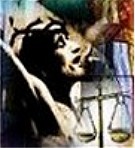
Download Study Card
Stay Strong in the LORD...
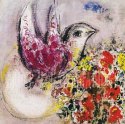
03.28.11 (II Adar 22, 5771) The sages ask, "Why does the Torah use a repetitious expression, "Sanctify yourselves and you shall be holy" (הִתְקַדִּשְׁתֶּם וִהְיִיתֶם קְדשִׁים) (Lev. 11:44)? Because when we make an effort -- no matter how feeble at times -- to draw near to the LORD, He will draw near to us...
There is a story (told in the midrash) that wonderfully illustrates this idea: An old sage once saw a beautifully shaped rock which he very much wanted to bring as a gift to the Holy Temple in Jerusalem. However, the rock was too heavy for him to carry and he couldn't afford to pay porters to bring it to Jerusalem. The man prayed and asked God for help, and soon five angels (disguised as men) appeared to offer the man help. The sage told them that he would like them to carry the stone to Jerusalem, but he couldn't pay them. The five angels immediately offered to carry the rock on his behalf, but only if the man put his finger to the rock to "help" them carry it. The midrash states that although the angels didn't need man's help, the man was required to do what he could.... God then took care of the rest.
In this connection, the Dubner Maggid once told this parable: A tourist once checked into a hotel and asked the porter to bring his suitcase to the top floor, where he had rented a room. After an hour or so the porter knocked on his door and brought in the suitcase, sweating profusely and breathing heavily. "What did you put into your suitcase, stones?", the porter asked, "it is extremely heavy!" The tourist looked at him in surprise: "My suitcase is heavy? Not at all! Mine is very light. You must have mistakenly brought up someone else's suitcase!"
Do you feel "weary" about serving the LORD? Then maybe you have "picked up" some other agenda along the way. The Lord says, "You have not worshiped Me .. that you should be weary of Me... (Isa. 43:22). In other words, serving the LORD leads to freedom and simchah (joy). Indeed, the NT Greek word for the word for "joy" (χαρά) is directly related to the word "grace" (χάρις). If you find yourself "weighed down" in your service of God, something may be wrong -- and the burden you are carrying might be coming from a source other than God... Where the Spirit of the LORD is, there is liberty... God is not a "slave driver," and indeed the purpose of our redemption was to set us free to serve Him... Yeshua's burden is kal - light.
People necessarily value things, and therefore every person alive is a "worshipper" (i.e., a person who finds "worth" in something). The question that matters is what is your ultimate concern? What moves you to get out of bed in the morning, to go through your day, to have hope in your heart? What do you really want? Where are you really going? Each of us will stand before God for judgment one day and give account of his or her life... One day all that is hidden will be fully disclosed to the light...
"Let us not grow weary of doing good, for in due season we will reap, if we do not give up." (Gal. 6:9). Draw near to God -- and He will draw near to you (James 4:4; Heb. 11:6).
Postscript: Of course sometimes we indeed become weary in life - from sickness, from the world and its oppression, from heartache of life in a fallen world, from the battle with the devil, and so on, though it is vital to remember there is consolation given to us in Messiah, and heavenly food is given to strengthen us. I believe the LORD allows oppression to sometimes chasten us -- that is, to help us remember Him and our profound need for His love to reign within our hearts... As long as that is not settled, there is an ongoing lesson.
 |
Thoughts about Passover

03.28.11 (II Adar 22, 5771) In just three weeks - Monday night, April 18th - IY"H we will sit down with family and friends at the Seder table to celebrate Passover. In the Diaspora we observe eight days of Passover (in Israel for seven) and perform two seders (on the first two nights). According to Jewish tradition, we begin studying the laws of a major holiday 30 days before it begins. In the case of Passover, we begin immediately following Purim.
Passover (פֶּסַח) is one of the three "pilgrimage holidays" mentioned in the Torah, the other two being Shavuot (שָׁבֻעוֹת) and Sukkot (סֻכּוֹת). These are mentioned as "required" festivals in the Torah (Deut. 16:16) and symbolize the Divine process of Redemption -> Revelation -> Rest.
The number four is sometimes associated with Passover... The holiday has four traditional names: Chag Ha-Pesach (the holiday of the Passover [Num. 9:2]); Chag HaMatzot (the holiday of Unleavened Bread [Exod. 12:17-20]); Chag Ha-Aviv (the holiday of Spring [Deut. 16:1]), and Z'man Cheiruteinu (the Season of our Freedom). Above all, Passover is the yahrzeit (anniversary of the death) of Yeshua as our Passover Lamb. The Torah also uses four expressions of freedom to tell the Jewish people that He will take them out of Egypt ("I will bring you out"; "I will free you"; "I will redeem you"; and "I will take you as my own"), each expression of which is associated with one of the four cups of the traditional Seder. In addition, we speak of the "four sons," we ask "four questions" during the meal, and so on.
This coming Sabbath is called "HaChodesh" (the "Sabbath of the Month" [of Nisan]) and is therefore the last Sabbath of the Biblical year. In other words, it is the last Sabbath before the start of the Biblical New Year, which begins on Nisan 1 (i.e., Rosh Chodashim). It is a "wake up call" to begin spiritually preparing for the holiday....
Shabbat HaChodesh - שבת החדש

[ This coming Sabbath is called "HaChodesh" (the "Sabbath of the Month" [of Nisan]) and is the last Sabbath before the start of the Biblical New Year.... ]
03.28.11 (II Adar 22, 5771) Four special Sabbaths occur just before the start of Spring: two before Purim and two before Passover. Collectively, these Sabbaths are called "The Four Shabbatot" and an additional Torah reading is read on each of these Sabbaths in preparation for the holidays. The names of these Sabbaths are Shekalim, Zakhor, Parah, and HaChodesh, respectively.
The last Sabbath of the Biblical year is called Shabbat HaChodesh, the "Sabbath of the Month" of Nisan. This Sabbath is significant because marks the start of the Month of Redemption (i.e., Nisan) which God called "the beginning of months" (i.e., Rosh Chodashim). We honor this event by reading an additional passage from the Torah concerning the sanctification of the new moon (Exod. 12:1-20). We spiritually prepare for this month by taking time to study Passover and the coming spring Holidays:

The sages identify the commandment to sanctify the new moon of Nisan as the beginning of redemptive history for the Jewish people, and in particular of our responsibility to sanctify time. In other words, the commandment to observe the "the beginning of months" implies that we live by the Hebrew calendar with its cycle of festivals (i.e., the mo'edim). Note that this year the Biblical New Year begins on Monday, April 4th at sundown, and Passover begins exactly two week weeks later, on Monday, April 18th (at sundown). The entire calendar of the Biblical Year begins with the sighting of the coming new moon:
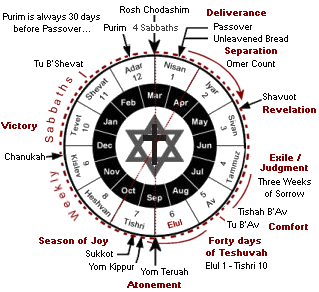 |
Originally Rosh Chodashim was simply called the "first month" because it is the month of the Exodus and the other months were named in relation to it, similar to the days of the week in the Hebrew calendar (i.e., the first day, the second day...). Later it was called "Chodesh Ha-Aviv" (חדֶשׁ הָאָבִיב), the springtime month, because the Jewish calendar is reset in the spring. So important is this month that the Jewish sage Rabbi Moshe ben Nachman (Ramban) wrote regarding the commandment to observe Rosh Chodashim:
"The verses (Exod. 12:1-2) mean that this month should be counted first, and beginning with it, the count should proceed to the second, the third, and so on, till the end of the sequence with the twelfth month. In this way, this month should be a commemoration of the Great Miracle (i.e., our Redemption), and every time we mention the months, the Miracle will be alluded to. It is for that reason that the months do not have names in the Torah, but rather they are identified by number."
According to the sages, since the prophecy of Jeremiah was fulfilled after the Babylonian Exile was complete (i.e., "it will no longer be said 'as the LORD lives, who took the people of Israel out of Egypt,' rather it will be said 'as the LORD lives, who raised up and brought the people of Israel from the Northern Land' (Jer. 16:14-15), the Jews continued to call the months by the names used in the Exile (i.e., Nisan, Iyar, etc.) as a commemoration of God's faithfulness. This also explains why these names of the months appear only in the post-Exilic books of the prophets and in the Book of Esther.
Rosh Chodesh Blessing:
Since Rosh Chodesh Nisan marks the new beginning of the Biblical year, we humbly ask the LORD to help us prepare for the coming month and the season of Passover:
יְהִי רָצוֹן מִלְּפָנֵיךָ יהוה אֱלהֵינוּ וֵאלהֵי אֲבוֹתֵינוּ
שֶׁתְּחַדֵּשׁ עָלֵינוּ חדֶשׁ טוֹב בַּאֲדנֵינוּ יֵשׁוּעַ הַמָּשִׁיחַ אָמֵן
ye·hi ra·tzon mil·fa·ne·kha Adonai E·lo·hei·nu ve·lo·hey a·vo·tei·nu
she·te·cha·desh a·lei·nu cho·desh tov, ba'a·do·nei·nu Ye·shu·a ha·ma·shi·ach, a·men

"May it be Your will, LORD our God and God of our fathers,
that you renew for us a good month in our Lord Yeshua the Messiah. Amen."

Download Study Card
Parashat Tazria
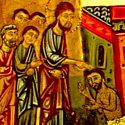
[ The following is related to this week's Torah reading (Tazria). Please read the Torah portion to "find your place" here. ]
03.27.11 (II Adar 21, 5771) Our Torah portion this week continues the discussion of the laws of "purity" (i.e., tahorah: טָהֳרָה) and "impurity" (i.e., tumah: טֻמְאָה) that began with parashat Tzav. It is important to remember that impurity (tumah) is not about hygiene as much as it about meeting the "spiritual conditions" for participation in ritual. For instance, while various natural factors can create a state of ritual uncleanness, some causes of uncleanness (e.g., caring for the sick, giving birth, burying the dead, etc.) are actually commendable. In fact, even some of the Torah's most important sacrificial rituals caused a state of uncleanness in the offerer (Lev. 16:26, 28; Num. 19:7-8). The Red Heifer sacrifice made the priest who sprinkled its ashes tamei (unclean), even though the defiled person became tahor (pure) through the act of sprinkling. In light of this, it is clear that uncleanness is not the same thing as sinfulness, and therefore purity and impurity are not necessarily related to good or evil.
Nonetheless, there is some ambiguity surrounding the case of a person afflicted with a skin disease called "tzara'at" (צָרַעַת), which was regarded as a "plague" in the skin of the flesh. In physical terms, the metzora (person afflicted with the disease) was quarantined from the camp, perhaps to minimize the risk of infecting others. In spiritual terms, however, the metzora was regarded to be in a protracted state of "impurity" that made him or her unfit for fellowship with the community. Unlike other natural causes that rendered someone impure, however, the sages associated the metzora with the phrase "one who brings forth [speaks] evil" (i.e., motzi ra: מוֹצְאִי רַע), and they thereby concluded that evil speech (i.e., lashon hara) was the principal cause of the disease itself. The sages said that God punished those who speak evil with middah-keneged-middah -- "measure for measure" justice, as can be seen regarding Miriam's lashon hara about Moses and her subsequent affliction with tzara'at (Num. 12:1-10). Since spreading evil reports divided others and caused isolation and loneliness, the metzora would be afflicted (with tzuris, troubles) and spiritually ostracized from the fellowship of Israel. In other words, there seems to be some "crossover" between the idea of uncleanness and sinfulness in the case of the person afflicted with tzara'at....
It is interesting that tzara'at could only be diagnosed by a kohen (priest), not a doctor. In other words, it was a spiritual malady that required spiritual discernment to both diagnose and treat. If someone was diagnosed with tzara'at, they were forced to leave society and undergo a period of mourning and teshuvah (repentance).
Lashon hara is traditionally defined as saying something bad about another person even if it happens to be true. In other words, "evil speech" involves spreading evil (even if true) reports, or expressing a negative or critical spirit about others. Such behavior is explicitly forbidden in Lev. 19:16. Yeshua told us that "out of the abundance of the heart the mouth speaks" (Matt. 12:34), and further warned us about the unthinking use of our words: "But I say unto you, that every idle word that men shall speak, they shall account for in the day of judgment. For by your words you shall be justified, and by you words you shall be condemned" (Matt. 12:36-37, see also Matt. 5:37). Note, however, that this does not mean that we are excused from making righteous judgments (John 7:24). Sometimes it is the mark of a coward to refrain from speaking the truth. As Albert Einstein once said, "The world is a dangerous place, not because of those who do evil, but because of those who look on and do nothing." We must "speak the truth in love," even if that means sometimes offending those who wish to excuse or overlook evil behavior...
A midrash states that when the children of Israel first heard the laws of tzara'at, they despaired and became very afraid. Moses reassured them by telling them that tzara'at was a sign from God that they were indeed a holy nation, since it is His way of encouraging them to do teshuvah in order to be in fellowship with Him. Likewise God sometimes disciplines us for our sins (Heb. 12:7-8) for the purpose of granting us the gift of teshuvah (2 Cor. 7:10). We must therefore strive to make our conversation and the inmost intent of our hearts "captive to the obedience of the Messiah," blessed be He (Matt. 5:37; Eph. 4:29; Col. 3:8; 2 Cor. 10:5; 1 Tim 4:2; etc.). Our thoughts are the "seed" for our actions...
In the New Testament we read how Yeshua healed various "lepers" and even touched them (Matt. 8:2-3, Mark 1:40-41). The healing by Yeshua is paradoxical, since anyone who touches someone afflicted with tzara'at became (ritually) unclean themselves, and yet we know that Yeshua was entirely without sin or impurity. He alone is the Healer of our uncleanness before God, and through His touch we are made acceptable for true spiritual worship. Thank the LORD God of Israel! The Lord Yeshua visits and heals us outside the camp! It is the prerogative of the LORD God of Israel to "touch" those afflicted with tzara'at and heal them based on their teshuvah, and in like measure, Yeshua entered the "leper colony" of humanity to heal those who cried out to Him. He is the same yesterday, today, and forever, and His love reaches down to those who are afflicted and oppressed on account of their uncleanness. If you call upon Him, He will likewise touch you and restore you to fellowship with God.
Blessed be His Name forever.
 |
New "Table Talk" for Shemini
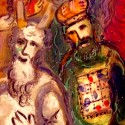
[ The following is related to this week's Torah reading (Shemini). Please read the Torah portion to "find your place" here. ]
03.25.11 (II Adar 19, 5771) Today I wrote a Shabbat "Table Talk" for this week's Torah portion (Shemini), the third portion of the Book of Leviticus. Like other Table Talk guides, I first provide a brief synopsis of the reading and then ask some provocative discussion questions. For instance, one question we ask is whether we should observe the dietary guidelines revealed in the Torah, or if we should regard them as somehow "obsolete" because of the teaching of the New Testament... I hope you find it helpful, chaverim. You can download the page here.
In addition to the regular weekly Torah reading, we also read Parashat Parah regarding the mystery of the Red Heifer sacrifice. The sacrificial death of Yeshua the Messiah is the secret fulfillment of the symbolism of the "red cow" (parah adumah). Both were entirely rare and without defect (sin); both were sacrificed outside the camp; both made the one who offered the sacrifice unclean but made the one who was sprinkled by it clean; and finally, both sacrifices cleanse people for priestly service. For more on this subject, see "The Gospel of the Red Cow," "Yeshua our Red Heifer," and "The Tenth Red Heifer."
Shabbat Shalom, chaverim. I wish you joy, peace, and great power from our LORD Yeshua, the Master of the Universe and our Beloved Savior and Mashiach. "Seek the LORD and be strong in the power of His might."
דִּרְשׁוּ אֶת־יְהוָה וִחְיו
dir·shu et Adonai vich·yu
"Seek the LORD and live"
(Amos 5:6a)
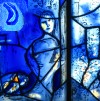
Thankful to the LORD
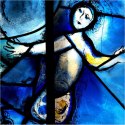
03.24.11 (II Adar 18, 5771) I would like to express my heartfelt thanks to all of you who are Hebrew for Christians visitors and supporters. As I've said before, this ministry literally could not exist apart from you and your encouragement. Please receive my thanks and appreciation for helping to make this work possible... I am inexpressibly grateful to the LORD for giving me this opportunity to serve others and to share the riches of His truth with you. "The LORD is good; his love (חֶסֶד) is eternal, and his faithfulness (אֱמוּנָה) is for all generations" (Psalm 100:5). The LORD is good to those who hope (קוה) for him, to the soul who searches (דָּרַשׁ) for him (Lam. 3:25). Blessed is the Name of the LORD.
אֲבָרֲכָה אֶת־יְהוָה בְּכָל־עֵת תָּמִיד תְּהִלָּתוֹ בְּפִי
a·va·ra·kha et Adonai be·khol eit ta·mid te·hi·la·to be·fi

"I will bless the LORD at all times;
his praise shall continually be in my mouth"
(Psalm 34:1)
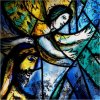
Hebrew Study Card
New Hebrew Meditation:
God's Search for Man
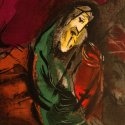
03.23.11 (II Adar 17, 5771) Over and over the Scriptures command us to seek God's presence. "Seek the LORD while he may be found; call upon him while he is near" (Isa. 55:6); "Seek the LORD and live" (Amos 5:6); "You will seek me and find me, when you search for me with all your heart" (Jer. 29:13). We are commanded to seek God because God wants to be sought; likewise, God seeks us because we desperately need His love... It is a "reciprocal seeking," a holy reconciliation, that the Spirit bears within us. As we draw near to God, He will draw near to us...
Today I wrote a brief Hebrew meditation ("God's Search for Man") based on Psalm 105:4, "Seek the LORD and his strength; seek His presence continually." I hope you find it encouraging, chaverim.
In need of prayer...

03.23.11 (II Adar 17, 5771) I am sick and my eyes are affected so that it is quite difficult to see. Please offer up a prayer for my healing, chaverim. Thank you so much....
Parashat Shemini - פרשת שמיני

[ The following is related to this week's Torah reading (Shemini). Please read the Torah portion to "find your place" here. ]
03.21.11 (II Adar 15, 5771) This week's Torah reading, Shemini ("eighth"), continues last week's reading (Tzav) where the seven-day inauguration ceremony for the Tabernacle and the priests was described. During each of the "seven days of consecration" (beginning on Adar 23) Moses essentially served as the first High Priest of Israel by offering sacrifices and training the new priests. On the eighth day (i.e., Nisan 1), however, God commissioned Aaron and his sons to officially begin their responsibilities as Israel's priests. The portion first describes the ceremonies performed to consecrate the altar. Now instead of Moses functioning as the High Priest, Aaron brought the various offerings, including sin offerings and whole burnt offerings for himself and for the elders of Israel. Aaron and his sons then offered additional sacrifices on behalf of the people as well.
After completing the sequence of offerings, Aaron blessed the people with Birkat Kohanim (i.e., the priestly blessing). However, the Glory of the LORD did not appear, and there was no Divine Fire (Shekhinah) that consumed the sacrifices. This was an anxious moment for the people, since it was unclear whether the LORD had accepted Aaron's offerings and therefore had forgiven Israel for the sin of the Golden Calf. Moses and Aaron then went into the Holy Place of the Mishkan and interceded, and after they came out to bless the people again, the Glory of the LORD appeared and the holy fire (in the form of a lion) consumed the offerings on the altar. When all the people saw it, they rejoiced and shouted and fell on their faces (Lev. 9:22-24).
The portion continues with the tragic account of the death of Aaron's two oldest sons, Nadab and Abihu. When they entered the Holy Place with an unuathorized incense offering (i.e., "strange fire," or esh zarah: אֵשׁ זָרָה), "fire came out from before the LORD and consumed them, and they died before the LORD" (Lev. 10:1-2). Aaron remained silent as his sons' bodies were removed by their cousins, and Moses warned Aaron and his two remaining sons, Eleazar and Ithamar, not to mourn for their brothers. The description of the "strange fire" has puzzled some commentators, though the context seems to link their death with the prohibition against drinking alcohol that immediately follows the narrative (i.e., the LORD spoke directly to Aaron at this time, saying, "Drink no wine or strong drink, you or your sons with you, when you go into the tent of meeting, lest you die. It shall be a statute forever throughout your generations" (Lev. 10:8-9)). Other commentators suggest Nadab and Abihu brought an additional (i.e., "strange") sacrifice and their death was intended to warn future priests never to deviate from God's explicit instructions for offering korbanot.
Moses then instructed Aaron and his two remaining sons that they were to required eat their portion of the sin offering made on behalf of the people within the Holy Place of the tent. When he "diligently searched" and discovered that the sacrifice had been consumed on the altar, he was angry, though Aaron responded that it would be unsuitable to partake of the offering after the death of his sons, and Moses held his peace (Lev. 10:16-20). Some of the sages note that the Hebrew text used to describe Moses' search (i.e., darosh darash: דָּרשׁ דָּרַשׁ, lit. "searching, he searched") marks the exact midpoint of the words in the written Torah scroll (Lev. 10:16). The midrash (Leviticus Rabbah) states that after Moses realized his error, he came before the elders of Israel and acknowledged that Aaron was right when he refused to eat. It is interesting that the midpoint of the Torah records the confession of Moses' mistake...
The Torah portion ends with a list of which animals, birds, fish and insects are permitted or forbidden as food, providing the framework for Jewish dietary law (i.e., kashrut: כַּשְׁרוּת). The Israelites were permitted to eat any mammal that both has a split hoof and chews its cud (Lev. 11:3). Both characteristics were required for the mammal to be regarded as kosher, and examples of animals that fail to meet these two qualifying attributes are given (e.g., the camel, the badger, the hare, and the pig). Likewise, only fish that have both scales and fins were to be regarded as kosher. A list of acceptable (i.e., non-predatory) birds was given, along with the commandment not to eat any insects unless they have a pair of jointed legs used for leaping.
All "scavenger type" creatures such as rats, mice, lizards, etc., are particularly forbidden, and anything touches their carcasses will be made unclean (טָמֵא). If one of these creatures falls into any earthenware vessel, all its contents will be unclean, and the vessel must be destroyed. Any such creature is to be regarded as a detested thing, or an "abomination" (i.e., sheketz: שֶׁקֶץ, from שׁ- ["that"] and קֵץ ["end"]).
It should be noted that many kosher laws are regarded as "chukkim," or laws for which God gave no rational explanation. They are to obeyed from a sense of trust and loyalty, not because they "make sense" to us... Nonetheless, some of the sages have attempted to discover reasons for these laws. For instance, some have said they were intended to promote hygiene or biological cleanliness in the camp. Others have said that they were designed to sensitize our hearts. If we must take away life in order to sustain our own, we should be conscious of the sacrifice and and humane in the way we do it... Others have said that the laws were intended to keep us from becoming "mindless eaters" who indiscriminately consume food. Still others have said certain food types were permitted by God because of inherent properties associated with that life form. For instance, kosher mammals and birds are non-predators and their consumption is intended to remind us of our need to be peace loving and community directed.
The Torah states that various dietary laws were intended to sanctify the Israelites by separating them for holiness: "For I am the LORD your God. Consecrate yourselves therefore, and be holy, for I am holy (וִהְיִיתֶם קְדשִׁים כִּי קָדוֹשׁ אָנִי)... For I am the LORD who brought you up out of the land of Egypt to be your God. You shall therefore be holy, for I am holy" (Lev. 11:44-45). The realm of the holy was to be applied to the daily and routine sustenance of life. You are "to distinguish (לְהַבְדִּיל) between the unclean and the clean and between the living creature that may be eaten and the living creature that may not be eaten" (Lev. 11:47). In other words, since eating is necessarily a sacrificial act, there is a connection between holiness and what goes in (and out) of our mouths. Whenever we eat food, we incorporate other life as a means of nourishment for our own. Physical food temporarily sustains our physical life, but after it is digested we find ourselves in need of it once again. Just as God has designed the human body so that it requires ongoing sacrifice to live, so he has designed the human spirit to require lechem ha-chayim, the "Bread of Life" in order to live (Deut. 8:3).
כִּי אֲנִי יְהוָה הַמַּעֲלֶה אֶתְכֶם מֵאֶרֶץ מִצְרַיִם
לִהְית לָכֶם לֵאלהִים וִהְיִיתֶם קְדשִׁים כִּי קָדוֹשׁ אָנִי
ki a·ni Adonai ha·ma·a·leh et·khem me·e·retz mitz·ra·yim,
lih·yot la·khem lei·lo·him, vih·yi·tem ke·do·shim, ki ka·dosh a·ni

"For I am the LORD who brought you up out of the land of Egypt
to be your God. You shall therefore be holy, for I am holy."
(Lev. 11:45)

Our Purim Spiel Pictures

03.21.11 (II Adar 15, 5771) Saturday night we staged a family "Purim Spiel" (i.e., Purim play) over at my in-laws home and had a lot of fun. The play opened with a "rabbi" (narrator) explaining the story of Purim to his young son and ended with the Jews of Shushan celebrating the new holiday of Purim. Here are a few pictures from the event:
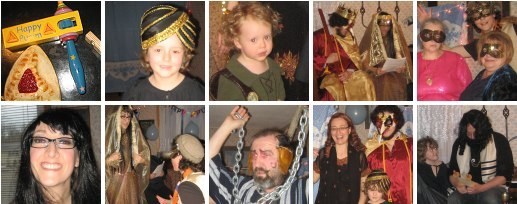
Left-to-right (top): 1. Purim groggers (noise makers); 2. Josiah as an advisor to the king;
3. Soon-to-be-two Judah (dressed as a messenger); 4. the king and Esther; 5. other advisors.
(bottom): 1. Queen Esther; 2. Esther and Mordechai; 3. the wicked Haman (boo!);
4. Vashti and the king; 5. the "rabbi" and his son.
After the play we ate a holiday meal (in costume) and enjoyed some festive fellowship. It was a happy occasion, and we wish you could have been there! Of course, with the passing of Purim, it's time to begin thinking about Passover (which begins about a month from now, on Monday, April 18th).
Shabbat Parah - שבת פרה
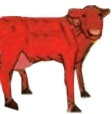
[ The Sabbath that immediately follows the holiday of Purim is called Shabbat Parah - the "Sabbath of the Cow" (Red Heifer). ]
03.20.11 (II Adar 14, 5771) Four special Sabbaths occur just before the start of Spring: two before Purim and two before Passover. Collectively, these Sabbaths are called "The Four Shabbatot" and one of four additional Torah readings (called Arba Parashiyot, or the "four portions") are read on each of these Sabbaths in preparation for the holidays. The names of these Sabbaths are Shekalim, Zakhor, Parah, and HaChodesh, respectively.
The Shabbat that immediately follows Purim is called Shabbat Parah - the "Sabbath of the Cow," when the chapter of the parah adumah (פָרָה אֲדֻמָּה), or the "Red Heifer" (Num. 19:1-22), is read following the regular Torah service. The early sages chose this reading for this time of the year because Jews were required to purify themselves before coming to Jerusalem for the pilgrimage festival of Passover.
The Red Heifer offering is considered a paradox to most Jewish thinkers, though it is clearly a picture of the Messiah Yeshua. The paradox is that the one who offers this sacrifice becomes ritually impure, while the sprinkling of the ashes is used to make people clean... The ritual is considered chok within the Jewish tradition, meaning that it transcends human reasoning. In fact, the Talmud states that of all the taryag mitzvot (613 commandments), this is the only one that King Solomon could not fathom, since this sacrifice is the most paradoxical of all the sacrifices found in the Torah. The sacrifice of Yeshua the Messiah is the secret fulfillment of the symbolism of the parah adumah. Both were entirely rare and without defect (sin); both were sacrificed outside the camp; both made the one who offered the sacrifice unclean but made the one who was sprinkled by it clean; and finally, both sacrifices cleanse people for priestly service.
The parah adumah had to be a perfect specimen that was completely red, "without blemish, in which there is no defect (mum)." The rabbis interpreted "without blemish" as referring to the color, that is, without having so much as a single white or black hair. This is the only sacrifice in the Torah where the color of the animal is explicitly required. Moreover, the parah adumah was never to have had a yoke upon it, meaning that it must never have been used for any profane purposes.

Unlike all other sacrifices offered at the mizbeach (altar at the Mishkan), the parah adumah was taken outside the camp and there slaughtered before the priest (in this case, Elazar, Aaron's son), who then took some of its blood and sprinkled it seven times before the Mishkan (thereby designating it as a purification offering). [During the Second Temple period, the High Priest performed this ceremony facing the Temple while atop the Mount of Olives.] Then the red heifer would be burned in its entirety: its hide, flesh, blood, and even dung were to be burned (unlike other Levitical korbanot). Significantly, unlike other offerings, the blood of this unique sacrifice was to be burned in the fire.
Hyssop, scarlet yarn, and a cedar stick would then be thrown upon the burning parah adumah (interestingly, these same items were used to cleanse from sin or tzara'at (skin disease). In other words, the blood was assimilated into the ashes of the sacrifice, which were then gathered and mixed with water to create the "water of separation" (mei niddah) for the Israelite community. Note that the word "separation" (niddah) refers to menstrual impurity and harkens to Zechariah 13:1: "On that day there shall be a fountain opened for the house of David and the inhabitants of Jerusalem, to cleanse them from sin and from niddah."
Anyone (or anything) that came into contact with a corpse (the embodiment of sin and death) was required to be purified using the mei niddah. The purification procedure took seven days, using stalks of hyssop dipped into the water and shaken over the ritually defiled person on the third day and then again on the seventh day. After the second sprinkling, the person undergoing the purification process would be immersed in a mikvah and then be unclean until the following evening.
The Uniqueness of the Sacrifice
The Parah Adumah sacrifice was entirely unique, for the following reasons:
- It was the only sacrifice that specifically required an animal of a particular color. This animal was extremely rare and unique of its kind (in fact, Maimonides wrote, "Nine Parot Adumot were prepared from the time the Commandment was given until the destruction of the Second Temple. Moses our Teacher prepared one, Ezra prepared one and seven more were prepared until the Destruction of the Temple. The tenth will prepared by the Mashiach." (We would say "was prepared" by the Mashiach Yeshua, blessed be He.)
- It was the only sacrifice where all the rituals were carried out outside of the camp (and later, outside the Temple precincts). That is, the "blood applications" of this sacrifice occurred in a location apart from the altar (the Talmud recounts that the High Priest performed the blood applications of the Red Heifer while gazing at the Temple and at the Holy of Holies from a mountain opposite the Temple mount).
- It was the only sacrifice that ritually contaminated the priest who offered it, but made the one who was sprinkled by it clean.
- It was the only sacrifice where the ashes were preserved and used (other sacrifices required the ashes be disposed outside of the camp).
According to Jewish tradition, this sacrifice was to atone for the sin of the Golden Calf, though the Torah itself does not make this association. The LORD Yeshua, our Mashiach, is the perfect fulfillment of the Parah Adumah, since He was completely without sin or defect (2 Cor. 5:21; John 8:46); He was sacrificed outside the camp (Heb. 13:13); He made Himself sin for us (2 Cor 5:21); His sprinkling makes us clean (1 Pet. 1:2; Heb. 12:24; Rev. 1:5); and the "water of separation" that His sacrifice created is the means by which we are made clean from the impurity of sin (Eph. 5:25-6; Heb. 10:22).
The Haftarah for Shabbat Parah
The Haftarah read for Shabbat Parah (Ezek. 36:16-38) is ostensibly linked to the sacrifice of the Red Heifer, though on a deeper level it relates to Israel's national salvation and return to the promised land after the Great Tribulation period.... Despite the horrors of the worldwide Diaspora of the Jewish people and their faithlessness before the nations, God will be true to His promises by causing the Jews to finally accept His salvation (i.e., Yeshua) and to return to the land of Israel. At that time, "all Israel will be saved," as the Apostle Paul also foretold (Rom. 11:26). For more information about this Haftarah, see the Shabbat Parah page here.
 |
Anticipating Passover

[ Since Purim is now over, we are beginning to think about Passover, which begins exactly one month later, on Nisan 15... ]
03.20.11 (II Adar 14, 5771) On the Biblical calendar the month of Adar (אֲדָר) is the last month of the year counting from Nisan (during a leap year it is called Adar II). Adar is the month of Purim, a festive holiday which is always celebrated a month before Passover (Megillah 1:4). During both Purim and Passover we celebrate God's deliverance of His people, and therefore Adar is considered one of the happiest of the months of the Jewish year: "When Adar comes, joy is increased" (Ta'anit 29a). This year Adar began on Saturday, March 5th, and Purim began two weeks later, under the full moon (i.e., Saturday, March 19th). That means that Passover will occur one lunar month later, on Monday, April 18th (at sundown):

Like the month of Elul (i.e., the month that precedes Rosh Hashanah and the New Year in the fall [Exod. 23:16]), Adar is a time to make "New Year's Resolutions" and to turn away from sin before the start of the New Year of spring. The month of Adar is therefore a season given to us each year to begin preparing for the holiday of Passover.
Sacrifice of Praise

[ The following is related to this week's Torah reading (Tzav). Please read the Torah portion to "find your place" here. ]
03.18.11 (II Adar 12, 5771) Our Torah portion this week includes the description of the "thank offering," (i.e., zevach ha-todah: זֶבַח הַתּוֹדָד), which was a type of peace sacrifice (i.e., shelamim: שְׁלָמִים) shared with others in praise for God's personal deliverance (Psalm 116:17). The Scriptures state, "Whoever offers a thank offering (זבֵחַ תּוֹדָה) glorifies me" (Psalm 50:23). The todah offering was unusual because it was accompanied with an elaborate offering of bread - including the offering of otherwise forbidden leavened bread (Lev. 2:11). "With the sacrifice of his peace offerings for thanksgiving he shall bring near (karov) loaves of leavened bread" (Lev. 7:13). The only other time leavened bread (i.e., chametz) was offered at the altar was during the holiday of Shavuot, as a token of thanks for the fulfillment of the wheat harvest. The wave offering (i.e., tenufah: תְּנוּפָה) of the two loaves prophetically pictured the "one new man" (composed of both Jew and Gentile) before the LORD, which was the climax of God's plan for the world's redemption through Yeshua, the true Passover Lamb of God. The 50 day countdown to Shavuot therefore anticipated the advent of the Holy Spirit given to the followers of Yeshua (Acts 1:8, 2:1-4).
The thank offering mentioned in the Torah reappears in the New Testament. In the Book of Hebrews were are instructed to "continually offer up a sacrifice of thanks (זֶבַח תּוֹדָה) to God, that is, the fruit of lips that acknowledge his Name" (Heb. 13:15). It is interesting to note that the Greek verb used to "offer up" (i.e., ἀναφέρω) is used to translate the Hebrew verb "to draw near" (karov) in Leviticus. In other words, the "offering up of thanks" for the sacrifice of Yeshua functions as "korban" and draws us near to God. Thanking God for personal deliverance constitutes "right sacrifices" (זִבְחֵי־צֶדֶק) as we draw near to God in the hope of His love (Psalm 4:5; Heb. 7:19).
לְךָ־אֶזְבַּח זֶבַח תּוֹדָה וּבְשֵׁם יְהוָה אֶקְרָא
le·kha ez·bach ze·vach to·dah, uv·shem Adonai ek·ra

"I will offer to you the sacrifice of thanksgiving
and call on the name of the LORD."
(Psalm 116:17)

The author of the Book of Hebrews states that "in these last days God has spoken to us by his Son, whom he appointed the heir of all things, through whom also he created the world" (Heb 1:2). The Greek construction for the phrase translated, "by his son" is ἐλάλησεν ἡμῖν ἐν υἱῷ, literally means "he spoke to us in son" -- that is, in the language or voice of the Son of God Himself... God now speaks in the language "of Son" from the midst of the fire revealed at Zion... Under the older covenant, sacrifices merely "covered" sins for a single year, but under the new covenant, these sins are taken entirely away (Heb. 7:27, 9:12, 9:25-28). There is no more need for continual sacrifices, since Yeshua provided the once-and-for-all sacrifice for all of our sins (Heb. 9:11-14; 9:24-28; 10:11-20). The sacrifice of Yeshua our Lord perfectly fulfills the need for the various sin and guilt offerings and gives us everlasting atonement with God. The ultimate meaning of the altar is revealed in the Cross of Yeshua (Heb. 13:10).
The Midrash (Vayikra Rabbah 9:7) says that in the days to come, when the Messiah will rebuild the Temple, the sin offering (chatat) and the guilt offering (asham) will no longer be needed and only thank offerings will be brought. Likewise, the Shemoneh Esrei will no longer be recited except for the blessing of Modim, thankfulness. This is because at that time "all Israel will be saved" and the prophetic fulfillment of Yom Kippur will be realized for the Jewish people. May that day come speedily...
Gratitude is foundational to our lives as followers of Yeshua. There are really only two prayers we ever offer to God, namely "Help, LORD!" and "Thank you, LORD." Meister Eckhart once remarked that if the only prayer you said in your entire life was, "thank you," that would suffice... Genuine prayer ultimately resolves to an expression of thanks. We are to "praise the Bridge that carries us over" into the Presence and Love of God, and that Bridge is Yeshua our Lord.
Personal Update: I could use prayer, friends. My shoulder has been hurting all week (due to an accident a few years ago) and I am pretty exhuasted from lack of sleep. My wife and children have been sick for the last couple weeks, too. Thank you... and Purim Same'ach.
 |
The Four Mitzvot of Purim
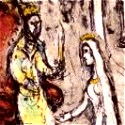
[ Note that the following entry is related to the festival of Purim, which begins at sundown Saturday, March 19th this year. For more information, see the Purim pages.]
03.18.11 (II Adar 12, 5771) The Scriptures state that the holiday of Purim "should be remembered and kept throughout every generation, every family, every province, and every city; and that these days of Purim should not fail from among the Jews, nor the memorial of them perish from their seed" (Esther 9:28). According to Jewish tradition, we remember the miracles of Purim by means of four mitzvot (blessings):
- Perform Acts of Tzedakah and Kindness
It is a mitzvah (blessing) to perform additional acts of kindness before the holiday of Purim begins. These include mishloach manot (מִשְׁלוֹחַ מָנוֹת), the "sending of portions" to friends (often anonymously or while in costume), and mattanot la'evyonim (מַתָּנוֹת לָאֶבְיוֹנִים), the giving of gifts (tzedakah) to the poor. (Fasting the daylight hours before Purim (ta'anit Esther) is also considered a blessing.)

Shalach Manot basket
- Honor the Appointed Time
It is a mitzvah to observe Purim on Adar 14 (which begins at sunset on the 13th). This is based on Esther 9:19: "Therefore the Jews of the villages, who live in the rural towns, hold the fourteenth day of the month of Adar (יוֹם אַרְבָּעָה עָשָׂר לְחדֶשׁ אֲדָר) as a day for gladness and feasting, as a holiday, and as a day on which they send gifts of food to one another." For Jews living in Israel, Purim is celebrated as Shushan Purim on Adar 15 (Esther 9:18). The Scriptures clearly state that we are to "keep these two days according to their writing, and according to their appointed time every year, and to remember (זכר) the days of Purim for all generations" (Esther 9:27-28).
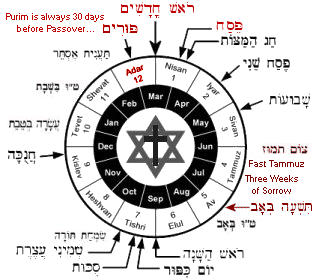
- Hear the Megillah Read
It is a mitzvah to hear the Scroll of Esther read twice on Purim: first during the evening service (usually followed by a costume play and oneg) and again during the following morning's service. (If you cannot attend services, reading the Book of Esther will suffice.) Before hearing or reading the Megillah, we recite the customary Hebrew blessings.

On Purim evening (i.e., erev Purim) it is a custom to give machatzit ha-shekel (half a shekel) as charity to the poor before the reading of the Megillah. During the reading, we "blot out" the sound of Haman's name by shouting or by using "groggers" (Haman's name occurs 54 times in the story). According to the Talmud (Megilah 7b), a person should be so merry that he doesn't know the difference between "cursed is Haman" (arur Haman) and "blessed is Mordechai" (baruch Mordechai) - "ad dela yada bein arur Haman le'varuch Mordechai." In Israel, special carnivals called Adloyada ("until you don't know") occur during Purim.
- Enjoy the Holiday Meal
It is a mitzvah to eat a special Purim meal (seudat Purim), usually after minchah (afternoon) services on the 14th. Many children dress up in elaborate masks and costumes for the supper. Like other holidays we light Yom Tov candles and recite kiddush before partaking of the meal (Mishna Berura 695:9). Often an oversized challah, sometimes shaped as a Star of David, is baked for the occasion.

Since Purim is a time of irony and fun, some people put on a farcical "Purim Seder," with a "Purim Rabbi" officiating the ceremonial meal and generally making a mess of things. It is also customary to eat festive foods at this time, especially the three-cornered pastries called "Hamantaschen" (המן־טאַשן), or "Haman's Ears."

Note: According to the Talmud (Megillah 7a), you should drink so much wine during the meal that you can no longer coherently know the difference between 'Cursed is Haman,' and 'Blessed is Mordechai.' This is sometimes called "ad lo yadah" - "until you don't know...." Needless to say this tradition is not a requirement and is in fact not recommended for the holiday celebration.
The Midrash Esther says that Purim, unlike many of the other holidays, will be celebrated even after the final redemption after the End of Days. Maimonides says that the Book of Esther will enjoy the same status as the Torah of Moses in the world to come (Mishneh Torah, Megillah). This is because the story of Purim -- i.e., God's covenantal faithfulness and defense of His people -- will be magnified in the deliverance that leads to the establishment of the Messianic Kingdom upon the earth. Indeed, the Second Coming of the Messiah will be regarded as the final fulfillment of Purim!
HAPPY PURIM CHAVERIM!
March 19th-20th
Should Christians Celebrate Purim?
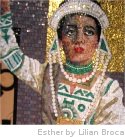
[ Note that the following entry is related to the festival of Purim, which begins at sundown Saturday, March 19th this year. For more information, see the Purim pages.]
03.17.11 (II Adar 11, 5771) Over the centuries, virtually no other book of the Tanakh ("Old Testament") has received more mixed reviews than the Book of Esther. In general it may be said that the book has been well received by the Jews, but disliked by most Christian theologians and "church" leaders. For example, the Jewish scholar Maimonides (the Rambam) praised Esther as being close in rank to that of the Torah itself: "When the Messiah comes, only Esther and the Torah will remain" (Mishneh Torah, Megillah). On the other hand, the Christian scholar Martin Luther detested the book and wished that it didn't exist at all, primarily because he thought it "Judaized" too much (Luther: Table Talk 24). Sadly, many Christian theologians have tended to agree with Luther and regard the book as unworthy of inclusion in the Bible, whereas many others do not seem to understand its message. Some Christian teachers have defamed the Book of Esther as being "a memorial to the nationalistic spirit of Judaism" (A. Weiser, Intro to OT, 1961) and even a "bloodthirsty attempt to justify ethnic pride in being a Jew" (B.W. Anderson, Esther, 1950). Others have stated that "there is not one noble character in the entire book" (L. B. Paton, The Book of Esther, 1908). Indeed, more Christian anti-Semitic statements have been made regarding the Book of Esther than any other book of the Old Testament (Moore: Esther, 1971). Do you wonder why this might be the case?
Anti-Jewish Bias in the Church
Perhaps such anti-Jewish statements have been made about the Book of Esther because many Christian theologians are essentially anti-Jewish in their thinking.... After all, the basic point of the book centers on God's providential care for ethnic Israel, and theologians such as Luther typically find this conclusion abhorrent to their theological biases. Indeed, the Book of Esther leads inescapably to the celebration of Jewish identity and survival despite the evil plans and designs of anti-Semites, and therefore Christian theologians who believe that the church replaces Israel will tend to regard the message of the book with deep suspicion (hence some teachers openly express indifference to the existence of the modern State of Israel today). For those who understand that the church partakes of the covenantal blessings given to Israel, however, the Book of Esther is a beautiful story about God's faithful love and care for His people...
Some Christian theologians attempt to "excuse" their oversight of the Book of Esther because they find in it no obvious message for the Church. Unlike the Torah-based holidays of Passover and Shavuot (which they regard as fulfilled in the New Testament), the Book of Esther seems parochial in its focus and "disconnected" from the rest of the Scriptures. In other words, since the Book of Esther (and therefore the holiday of Purim) celebrates the existence and perpetuity of the Jewish people, these theologians regard it to be of little consequence for Christians. This is actually quite an astounding conclusion, however, especially since Esther is part of the Christian canon of Scripture, and the book clearly states that "these days should be remembered and kept throughout every generation, in every clan, province, and city, and that these days of Purim should never fall into disuse among the Jews, nor should the commemoration of these days cease among their descendants" (Esther 9:28). It is painfully obvious that the only way to ignore the message of the book is to deny the Jewish roots of the Christian faith. How your church leaders regard the Book of Esther is a test case of whether or not they accept the heretical doctrine of Replacement Theology...
Continue reading here...
 |
The Fast of Esther

[ The Fast of Esther is observed from sunrise to sunset on March 17th this year... ]
03.16.11 (II Adar 10, 5771) Ta'anit Esther (תַּעֲנִית אֶסְתֵּר), the Fast of Esther, recalls the three days that Queen Esther fasted before approaching King Ahasuerus on behalf of the Jewish people (Esther 4:16, 9:31). Rabbinical tradition says that Esther originally called for the three day fast from Nisan 14-16, that is, during Passover, in order to stress the severity of the need for God's intervention and deliverance.
Today Jews remember Esther's fast on the day before the festival of Purim. Unlike the original fast, the modern observance is not observed for three days, nor is it observed during the Passover season. Instead, the fast is observed on the day that Haman's evil decree called for the extermination of the Jewish people (i.e., on Adar 13). Note, however, that if Adar 13 falls on a Shabbat (as it does this year), the fast is moved to the preceding Thursday (since it is forbidden to fast on Shabbat).
Since the holiday of Purim is such a festive time, the Fast of Esther functions as a sort of "prelude" to anticipate the joy over deliverance. It is also a time to solicit the LORD for other purims needed in this dark world... This year the fast is observed from sunrise to sunset on Thursday, March 17th.
Note: Just before the holiday of Purim it is customary to send gifts of food to friends called mishlo'ach manot (מִשְׁלוֹחַ מָנוֹת) and to give tzedekah to the poor, called matanot la'evyonim (מַתָּנוֹת לָאֶבְיוֹנִים). Both of these customs come from the story of Esther itself (Esther 9:22).
 |
Theology, Paradox, and Purim

[ Note that the following entry is related to the festival of Purim, which begins at sundown Saturday, March 19th this year. For more information, see the Purim pages.]
03.16.11 (II Adar 10, 5771) The theme of the holiday of Purim (פּוּרִים) is the providential survival of the Jewish people despite various attempts by their enemies to destroy them. As such, Purim (like Passover) is a celebration of the deliverance and faithfulness of the LORD God of Israel. The terrible irony of the anti-Semite is that he hangs himself using his own rope. The tragic character of Haman, then, represents the Biblical archetype of all those who refuse to acknowledge God's faithful love for the Jewish people....
On the Jewish calendar, both the last month of the year (Adar) and the first month (Nisan) center on the theme of God's salvation. In Adar we celebrate Purim, and 30 days later we celebrate Passover... However Purim, unlike Passover, celebrates the "hiddenness" of God's actions. There is no dramatic power encounter; no parting of the Red Sea, no cataclysmic judgments with Purim. This is suggested by the name of the Book of Esther itself, Megillat Ester (מְגִלַּת אֶסְתֵּר), since the word megillah ("scroll") is related to the word giluy (גִּלּוּי), "revelation," and the word Ester is related to the word hester (הֶסְתֵר), meaning "hiddenness." The phrase hester panim (הֶסְתֵר פָּנִים) means "hiding of face" and is often used when discussing the role of God in the Book of Esther. God's plan is being fulfilled, step-by-step, even if it is hidden within the "natural" world of human beings and their choices (Jer. 10:23; Prov. 21:1).
Though the Name of God is not explicitly mentioned in the Book of Esther, the story is essentially about revelation, that is, the disclosure of God's Presence despite His apparent concealment (this is implied in the life of Esther herself, who lived an "assimilated life" but later revealed her identity to the king). Throughout the story what initially appears to be the result of mere "chance" or human contrivance is later revealed to be an integral part of God's plan of deliverance.
Continue reading here...
 |
Table Talk for Parashat Tsav

[ The following is related to this week's Torah reading (Tzav). Please read the Torah portion to "find your place" here. ]
03.16.11 (II Adar 10, 5771) Today I wrote a Shabbat "Table Talk" for this week's Torah portion (Tzav), which is the second portion of the Book of Leviticus. Like other Table Talk guides, I first provide a brief synopsis of the reading and then ask some discussion questions. I hope you find it helpful, chaverim. You can download the page here.
Note: Now it's time to get ready for PURIM, which begins at sundown March 19th. We are planning on putting on our annual "Purimspiel" this coming Saturday night. Our youngest son Judah still needs a costume -- we are thinking he would make a great guard at the palace....
More on Holiness
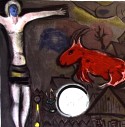
[ The following entry is related to this week's Torah reading (Tzav). It is a bit technical, so please skip it if you do not find it helpful. Shalom chaverim. ]
03.15.11 (II Adar 9, 5771) I recently mentioned that the most common Hebrew word used to describe "sacrifice" is korban (קָרְבָּן), which comes from the root karov (קָרַב) meaning to "draw close" or "to come near." In the Tabernacle, korbanot (קָרְבָּנוֹת) were various ritual acts that were used for the worshipper to draw near to the LORD. I also mentioned that the general theme of the Book of Leviticus is holiness (i.e., kedushah: קְדֻשָּׁה) and noted that the Hebrew root for holy (i.e., kadosh: קדשׁ) occurs over 150 times in the book. The message of Leviticus is that since God is holy, we must be holy in our lives as well, and this means first of all being conscious of the distinction between the sacred and the profane, the clean and the unclean, and so on: "You are to distinguish between the holy (i.e., ha-kadosh: הַקּדֶשׁ) and the common (i.e., ha-chol: הַחל), and between the unclean (i.e., ha-tamei: הַטָּמֵא) and the clean (i.e., ha-tahor: הַטָּהוֹר)" (Lev. 10:10, see also Ezek. 44:23). Just as God separated the light from the darkness (Gen. 1:4), so we are called to discern between (בֵּין) the realms of the holy and the profane, the sacred and the common, and the clean and the unclean. Indeed, the Torah states "God called the light Day, and the darkness he called night," thereby associating His Name with the light but not with the darkness (Gen. 1:5).
Spiritually understood, the Mishkan physically represented the separation of these realms, as may be illustrated with the following diagram:
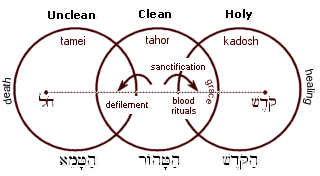
When applied to the Mishkan, the word "clean" (i.e., tahor: טָהוֹר) refers to that which is pure (such as the refined gold used for the Tabernacle furnishings), or that which is ceremonially clean (as animals fit for sacrifice, water used for purification, vessels, clothing, etc.). Metaphorically tahorah refers to ethical purity or cleanliness, such as pure eyes (Hab. 1:13), clean hands (Job 17:9), refined words (Psalm 12:6), and a pure heart (Psalm 19:9; 51:10). The word "unclean" (i.e., tamei: טָמֵא), on the other hand, denotes defilement or desecration that results in a state of tumah (טֻמְאָה), or "spiritual contamination." Personal uncleanness could be incurred through natural means (i.e., childbirth, menstruation, bodily emissions, skin diseases, sexual relations, contact with a corpse, etc.) or by various kinds of ethical misdeeds (sins, iniquities, and transgressions). Since impurity could be transmitted by physical contact (Num. 19:22), being ritually unclean meant you were disqualified to enter the Tabernacle for a prescribed period of time. (Note that the sages later said that the source of impurity defiled the first contact, which in turn defiled the second contact, but then the impurity transmitted no further in the chain.)
What is clear is that the realm of the holy must be separate from the realm of the unclean, and the two must never meet (Lev. 7:20-21; Num. 5:2-3). This explains the category of the "clean" and how it functions as an entryway to the realm of the holy. Both uncleanness and holiness are spiritual properties that can be transmitted (Exod. 29:37; Lev. 6:18; 7:19; 11:32; Num. 19:22). For instance, if a holy person (e.g., a priest) touched a corpse, he became unclean (Lev. 21:1); likewise, if an unclean person ate holy food, he would be "cut off" from the people (Lev. 7:20-21). Some things are decreed as inherently unclean (for instance, certain kinds of animals, corpses, and so on), though other things are potentially clean even if they are in a state of temporary uncleanness. For instance, while various natural factors can create a state of uncleanness (e.g., menstrual discharge, etc.), some causes of uncleanness (e.g., caring for the sick, delivering a baby, burying the dead, etc.) are actually commendable. In fact, even some of the Torah's most important sacrificial rituals caused a state of uncleanness in the offerer (Lev. 16:26, 28; Num. 19:7-8). For instance, the Red Heifer sacrifice made the priest who sprinkled its ashes tamei (unclean), even though the defiled person became tahor (pure) through the act of sprinkling. The picture of the priest here is one of sacrificial love - the giving up of one's own spiritual purity so that another person can regain his purity... In light of this, it is clear that uncleanness is not the same thing as sinfulness, even though it was indeed regarded as a serious transgression to bring uncleanness into the realm of the sacred. The way to the holy was through a regulated process whereby temporary uncleanness was purified by sacrifices and cleansing rituals administered by the priests.
It is noteworthy that being "clean" (tahor) is a sort of "in-between" (or default) state that separates the realm of the unclean (tamei) from the realm of the holy (kadosh). Ethically understood, being ritually clean provides the opportunity to draw close to God through faith in God's sacrificial provisions. As such, it is a place of decision, or more properly, it represents the condition that allows for faith to be expressed. Faith in the efficacy of sacrifice leads to sanctification (lit. "making holy"), which was the grace by which a person could draw near the Holy One (the portions of the sacrifices that were eaten - whether by the priest or by the offerer - had to be consumed in a state of taharah). On the other hand, unbelief leads to defilement (or pollution), which was the natural process of degradation that alienated the soul from the Divine Presence.
The purpose of the altar at the Tabernacle was to cleanse the unclean sinner so that he or she could draw near to a Holy God. Because of the radical separation between the realm of the unclean and the realm of the holy, no unclean person could make contact with God without facing death (the separation between the profane and the sacred is regarded as absolute). Because of this, God instituted sacrificial blood as the cleansing agent that purified from the effects of defilement and sin (Lev. 17:11; Heb. 9:22).
הֶרֶב כַּבְּסֵנִי מֵעֲוֹנִי וּמֵחַטָּאתִי טַהֲרֵנִי
he·rev ka·be·sei·ni me·a·vo·ni, u·me·chat·ta·ti ta·ha·rei·ni

"Wash me thoroughly from my iniquity, and cleanse me from my sin."
(Psalm 51:2[e])

Download Study Card
We can see the process of purification by considering the case of the metzora (or "leper") as described in Leviticus 14. First, the unclean person was excluded from the camp, since the community was to be entirely holy (Lev. 7:21; 11:45; 22:3; Num. 5:2-3). If the one suffering from tzara'at (i.e., the metzora) had undergone teshuvah (repentance) and had apparently been healed, he would first call for the priest to be reexamined. If the priest saw no sign of tumah (uncleanness), a second examination was scheduled seven days later, and if the metzora was free from the disease, the process of tahara (purification) would begin.
The purification process was somewhat elaborate: After the second examination, the priest required that the metzora bring the following items for his cleansing:
- An earthenware bowl filled with spring water (mayim chayim)
- Two birds of the same type (whether turtledoves or pigeons)
- A stick of cedar wood
- A hyssop branch
- A scarlet thread
The priest then commanded that one of the birds should be slaughtered over the earthen vessel filled with fresh spring water, with its blood mixing with the water. The living bird, the piece of cedar, and the hyssop branch were then tied together using the scarlet thread, and the entire bundle was dipped into the earthen vessel. The blood and water mixture was then sprinkled seven times on the healed metzora, and the other bird was then set free.
Next, the afflicted person washed his clothes, shaved off all his hair (including his eyebrows), and bathed in a mikveh (ritual pool for cleansing). After that he may return to the general camp - but he may not return to his home for another seven days. On the eighth day he would bathe again and offer several offerings (a chatat, an asham, an olah, and a minchah), but the blood from the asham (guilt) offering was mixed with oil and applied to his earlobe, thumb and foot, similar to the blood applied to the priests during their ordination. Oil from a meal offering was sprinkled seven times in the direction of the Sanctuary. Only after all this was he pronounced tahor (clean) by the priest. His life of uncleanness would be over, and he would be like a man who was brought back from the dead to renewed life.
This purification ritual corresponded with other rituals revealed in the Torah. The sprinkling of the hyssop by the priest recalled the blood of Passover; the offering made of the two birds - one which was sacrificed and the other set free - recalled the scapegoat of the Yom Kippur ritual. The washing of garments, the shaving of all hair, and the immersion in a mikveh recalled the birth of the Jewish people at the Sea of Reeds. The blood of the guilt offering applied to the earlobe, thumb and foot, recalled the dedication of Aaron and his sons as the priests of Israel (Lev. 14:14). In other words, the individual purification process mirrored the purification of the community of Israel, and healing ultimately meant being reidentified as a redeemed child of God. In a very literal sense, then, we see how the metzora was "reborn" by water and by the blood (John 3:5; 19:34; Heb. 9:19).
"The Messiah -- what is his name?... The sages say, the Leper Scholar..." (Sanhedrin 98b). But how was it that Yeshua was able to touch the metzora ("leper") and yet remain clean himself (Matt 8:1-4)? Only because He is the LORD, the Healer. Just as Yeshua spoke with greater authority than Moses (Matt. 5:21-48), so He was able to do what Moses (and those under the Levitical system of worship) could not do -- namely, reach down in compassion and take away the uncleanness from our lives.... Yeshua's blood creates the "waters of separation." He is the fulfillment of the "Red Heifer" sacrifice. Only Yeshua enters the "leper colony" of humanity and takes away our tzara'at (sin) by becoming ish machovot (אישׁ מַכְאבוֹת), a leper Himself, the Just for the Unjust, that He might make us acceptable before the LORD. As the prophet Isaiah wrote of Messiah:
"He is despised and rejected of men, a man of pains (אִישׁ מַכְאבוֹת) and acquainted with sickness (וִידוּעַ חלִי), and we hid as it were our faces from him. He was despised and we esteemed him not. Surely he has carried our sicknesses (חֳלָיֵנוּ) and borne our pains (מַכְאבֵינוּ), yet we esteemed him as plagued (נָגַע), smitten of God (מֻכֵּה אֱלהִים) and oppressed. But he was pierced (מְחלָל) for our transgressions (פְּשָׁעֵנוּ), he was crushed for our iniquities (עֲוֹנתֵינוּ): the discipline for our peace was upon him (מוּסַר שְׁלוֹמֵנוּ עָלָיו); and in his blows we are healed. All we like sheep have gone astray; we have turned every one to his own way, but the LORD has attacked in him (הִפְגִּיעַ בּוֹ) the iniquity of us all" (Isa. 53:3-6)
"The LORD has "attacked in him (הִפְגִּיעַ בּוֹ) the iniquity of us all..." (Isa. 53:6). Through the substitutionary sacrifice of the righteous Suffering Servant, Yeshua, we are both forgiven and made free from the power of sin and death. Because of Him we are no longer "lepers" or outcasts from the community of God but are made clean through His loving touch.
Postscript:
According to Gunther Plaut (The Torah, Shmini, 724), the Pharisees later attempted to emulate the laws of the priesthood and devised various rules of purity in their daily life. For example, they formed "societies" whose members pledged to eat food only while in a state of ritual purity demanded by the priests. Yeshua, of course, had a problem with this, since it grossly distorted the divinely given means for purification (i.e., the sacrificial system) and thereby impugned His overall mission as the sacrificial lamb of God. The problem of sin, defilement, death, and so on, required nothing less than divine intervention on behalf of the leper colony of humanity, not game-playing by religionists.
 |
Purim and Deliverance

[ Note that the following entry is related to the festival of Purim, which begins at sundown Saturday, March 19th this year. For more information, see the Purim pages.]
03.14.11 (II Adar 8, 5771) Do you remember this scene from the Fiddler on the Roof? A young man named Labish approaches the dear and wise old Rabbi and asks him, "Is there a proper blessing for the Czar?" Everyone is astounded at the idea. A blessing for the czar? The gentle Rabbi responds that indeed there is indeed a proper blessing for the czar: "May God bless and keep the Czar -- far away from us!" (Amen!)
The holiday of Purim is one of the most joyful of the Jewish year. We remember that long ago, in the city of Shushan (in ancient Persia), a wicked political sycophant named Haman attempted to blame the Jews for being different and to initiate a pogram for their extermination. The Jews were saved through the intervention of a queen named Esther (Hadassah) and her cousin Mordechai, both of whom were providentially enabled by God to overturn the evil decree of the King of Persia (the story is told in the Book of Esther). Throughout the centuries, in various places, many others have likewise tried to destroy the Jewish people, but none has succeeded. עַם יִשְׂרָאֵל חַי / am Yisrael chai: "The people of Israel live!" God's sovereign hand works all things together for good, even if at times things appear bleak and desperate (Rom. 8:28).
The name Purim (פּוּרִים) refers to the "lots" (i.e., dice) that Haman and his magicians used to determine the "best day" to carry out their nefarious plan. Haman's dice rolled "Adar 13," but since the Jews were delivered on the following day, the holiday is celebrated on the 14th of Adar (which this year begins on Saturday, Feb. 27th at sundown). In other words, Adar 14 was ironically transformed from a day of potential tragedy and grief into a time of great rejoicing! (In Israel, Purim is observed a day later still (i.e., on Adar 15th) and is called Shushan Purim, since the deliverance of the Jews of Shushan did not occur until the 15th.) Among other things, the delicious irony of the Book of Esther reveals that there is no "chance" in God's universe, since He is the Master of the universe and supervises all it outcomes - including the "roll of the dice" (Prov. 16:33).
During Purim is is customary to dress up in costume and listen to the Book of Esther (i.e., megillat Esther, מְגִלָּת אֶסְתֵּר, or "the megillah") recited from the Hebrew scroll (before we hear the Megillah read, we recite three Purim blessings). Some people will dress as the noble Mordechai, others as the foolish king Ahashuerus, others as Esther, and so on. Part of the fun is that we are told that it's very important that we hear every word recited clearly, so we must keep very quiet as the story is being read. However, whenever we hear the name "Haman," we whirl groggers (ra'ashanim), blow whistles, stamp our feet, and make such a commotion that we can't hear his name. This is the only time we are encouraged to be boisterous when the Scriptures are being read.
After reading the Megillah, many communities put on their own "purimspiel" (Purim play) to reenact the dramatic story, with children dressed up as the characters of the play... Others put on "Purim puppet shows" at this time. It is a time of merrymaking and fun. Later we eat a festive meal (called a seudah, סְעֻדָּה) and enjoy three-cornered pastries called oznei Haman (אָזְנֵי הָמָן), or "Haman's Ears," for dessert (legend says that Haman's ears were twisted and triangular in shape). In Yiddish, these are called a hamantaschen (המן־טאַשן) and are often filled with prunes, chopped nuts, apricots, apples, cherries, chocolate, and so on. Eating Haman's Ears fit the delicious irony recounted in the Book of Esther....

It is a custom to send bags or baskets of hamantaschen, candy, and fruit to friends and family members at this time. This is called mishloach manot (מִשְׁלוֹחַ מָנוֹת), the "sending of portions," and is intended to ensure that everyone has enough festive food for the Purim meal held later in the day. In addition, many families and communities collect food and toys for people in hospitals and nursing homes, while others give money to charities. This tzedakah (צְדָקָה) is called Mattanot La'evyonim (מַתָּנוֹת לָאֶבְיוֹנִים), "gifts for the poor," and is considered especially important at this time. (The ideas behind both manot and mattanot come from Esther 9:22).
On Purim we remember how the Jewish people escaped from Haman's evil plot to destroy them, though according to the sages, any day that is marked by special deliverance by God may be regarded as a "personal" or "special" Purim. Therefore some Jewish families and communities celebrate "special purims" to commemorate the anniversary of a particular deliverance. The most importance deliverance we have comes from being set free from the guilt of our sins, of course, since this gives us true peace with God (Rom. 5:1). In fact, Yom Kippur (the Day of Atonement) is also known as Yom Kippurim in the Tanakh, which can be read as Yom Ke-Purim, a "day like Purim." Thus the day on which Yeshua sacrificed Himself on the cross is the greatest Purim of all, since through His loving intervention we are eternally delivered from the hands of our enemies. יְהִי שֵׁם יְהוָה מְברָךְ / yehi shem Adonai mevorakh: "Blessed be the Name of the Lord."

Personal Update: My wife Olga has a kidney infection and the kids have been sick for the last month or so. I have also been sick, too. Please keep us in your prayers, chaverim. This ministry is only possible through the faith and kindness of our friends....
Parashat Tzav - צו

[ The following entry relates to this week's Torah reading (Tzav). Please read the Torah portion to "find your place" here. ]
03.13.11 (II Adar 7, 5771) The Torah portion for this week (i.e., for Shabbat Zakhor) is parashat Tzav. Of particular interest in this Torah portion is the Ram of Ordination (i.e., eil ha-milu'im: אֵיל הַמִּלֻּאִים) whose blood was sprinkled upon Aaron as the Kohen Gadol of the newly established Mishkan (Tabernacle).

The blood of the ram was put on the right ear, right thumb, and big toe of the Aaron and his sons (a clear picture of Yeshua and His sacrifice as the coming greater High Priest) and the rest of the blood was dashed upon the sides of the mizbe'ach (altar). After its slaughter, Moses also took the innards of the ram and some unleavened bread and put them in the hands of the priests to perform tenufah (a wave offering) before burning them upon the altar (a picture of the resurrection). Finally, Moses mixed some of the blood of the ram and anointing oil and sprinkled it on the priest's garments to sanctify them.
As believers in Yeshua, we too have been anointed with the blood from the Ram of Ordination -- Yeshua as our Kohen Gadol of the better covenant (Heb. 8:6)! And we too have been anointed with the sacred shemen (oil) that symbolizes the presence and aroma of the LORD in our lives. As followers of Yeshua we are therefore truly "...a chosen race, a royal priesthood, a holy nation, a people for his own possession, that you may proclaim the excellencies of him who called you out of darkness into his marvelous light" (1 Peter 2:9). May the LORD be pleased to help you serve Him in the truth.
 |
Shabbat Zakhor - שבת זכור
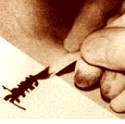
[ Shabbat Zakhor, the "Sabbath of Remembrance," occurs immediately before the holiday of Purim. The Amalekites mentioned in the Torah portion are traditionally associated with the ancestors of Haman, the villain in the Purim story.... ]
03.13.11 (II Adar 7, 5771) The Shabbat that precedes Purim is called Shabbat Zakhor - the "Sabbath of Remembrance." The Maftir (additional reading) commands us to "remember" (זָכוֹר) how the nation of Amalek functioned as Satan's emissary by attacking the Jews at Rephidim, immediately following the Exodus from Egypt (see Exod. 17:8-16). After Israel routed the attack, God told Moses, "Write this as a memorial in a book and recite it in the ears of Joshua, that I will utterly blot out the memory of Amalek from under heaven" (Exod. 17:14). Moses later explained that Amalek did not fight using conventional methods of war but rather attacked and killed the weakest members of Israel, "those who were lagging behind" in the camp (Deut. 25:17-19). This cowardly approach represented the first attack of God's newly redeemed people, a Satanic assault that God vowed never to forget.... Amalek therefore embodies satanic forces arrayed against the people of God.
The name "Amalek" (עֲמָלֵק) begins with the letter Ayin (symbolizing the eye) and equals 240 in gematria -- the same value for safek (סָפֵק), the Hebrew word for doubt. Amalek therefore suggests "the eye of doubt," or even "the severed eye" (the Hebrew verb מָלָק means "to chop" or "sever" in reference to the "eye" of Ayin). Amalek therefore represents spiritual blindness as it acts in the world... It is customary for Jewish soferim (scribes) to literally blot out the name Amalek when they test their quills before writing a Torah scroll....

The additional Haftarah portion (1 Sam. 15:2-34) speaks of how King Saul later failed to "devote to destruction" the sinful tribe of Amalek -- a mistake which cost him the kingship of Israel. Samuel's rebuke of Saul's compromise is always timely: "Behold, to obey is better than sacrifice, and to listen than the fat of rams.... Because you have rejected the word of the LORD, he has also rejected you from being king."
These two readings were selected before Purim because Haman was an Agagite (Esther 3:1), i.e., a direct descendant of Agag, the king of Amalek (whom Saul nearly spared, see 1 Sam. 15:32-33), and we should therefore link the 'wiping-out' of Haman with the 'wiping-out' of Amalek. The spiritual war between the light and the darkness admits of no compromise. For more about this Sabbath, click here.
Table Talk for Parashat Vayikra

[ The following is related to this week's Torah reading (Vayikra). Please read the Torah portion to "find your place" here. ]
03.11.11 (II Adar 5, 5771) Today I wrote a Shabbat "Table Talk" for this week's Torah portion (Vayikra), which is the first portion of the Book of Leviticus. Like other Table Talk guides, I first provide a brief synopsis of the reading and then ask some discussion questions. I hope you find it helpful, chaverim. You can download the page here.
Shabbat shalom and love to you in our beloved Yeshua, the victorious "Lamb of God" who takes away the sins of the world! Thank you for standing with this ministry, chaverim...
Why the Sacrifices?
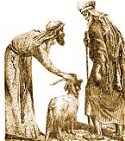
[ The Bible is described as a "book of blood and a bloody book." In the Torah, just as in the New Testament, sacrificial blood is connected to atonement and the forgiveness of sin. The following is related to this week's Torah reading (Vayikra). Please read the Torah portion to "find your place" here. ]
03.10.11 (II Adar 4, 5771) The Book of Leviticus (וַיִּקְרָא) centers on the various laws of sacrifice pertaining to the Mishkan (Tabernacle), and therefore it is undeniable that sacrifice is an integral part of the both Jewish law and the Torah. Indeed, even today the traditional Jewish liturgy includes prayers that appeal for the rebuilding of the Temple and the reinstatement of the sacrificial system. Nonetheless the sages wondered why God demanded offerings of animals and grain as part of his worship. Surely God has no physical need for these things: "For every beast of the forest is mine, and the cattle upon a thousand hills" (Psalm 50:10). Unlike pagan sacrificial rites, the sacrifices of the Torah were never intended to "bribe" God or to curry His favor. The Jewish people were designated a "kingdom of priests and a holy nation" during the time of their liberation from Egypt, even before the pattern of the Mishkan had been revealed at Sinai (Exod. 19:6).
Let's review a little Torah history. The very first sacrifice of the Torah was offered by God Himself, when He slaughtered a lamb to cover the shame of Adam and Eve (Gen. 3:21). According to Jewish tradition, Adam built the first altar and offered sacrifices to the LORD as humanity's first high priest. Adam taught his sons about the law of sacrifice, though Cain's offering (מִנְחָה) was rejected (because it came from the fruit of the earth that was cursed) whereas Abel's was accepted because it was based on blood sacrifice (Gen. 4:3-5). When Adam later died, his son Seth (שֵׁת) became high priest in his place. When Seth later died, the priesthood went to Methuselah (מְתוּשָׁלַח) who served for centuries. Methuselah was prophesied to die seven days before the advent of the great Flood, and upon his death his grandson Noah (נחַ) was commissioned to be humanity's high priest.
The first occurrence of the word "altar" (i.e., mizbe'ach: מִזְבֵּחַ) occurs after the great flood (Gen. 8:20). According to Jewish tradition, Noah had learned the laws of sacrifice ("clean" and "unclean") from his forefathers and rebuilt Adam's original altar in Jerusalem (which had been destroyed earlier by wicked people of the generation of the Flood). Later, however, he was disqualified to be priest and his firstborn son Shem (שֵׁם) took his place. Shem remained in Jerusalem (i.e., Salem) and became its king and high priest (the name "Malki-Tzedek" was later ascribed to him as an honorary title). From Shem's line would come Abraham, through whom would descend the Jewish people. Of particular importance is the altar where Abraham sacrificed his son Isaac upon Mount Moriah (i.e., the Akedah). At the last minute, God stopped Abraham and provided a divinely appointed substitute (a male lamb, or ram) in place of his son. Thereafter each of the Hebrew patriarchs – Abraham, Isaac, and Jacob – offered sacrifices upon altars to the LORD (Gen. 12:8; 26:25; 33:20).
The theme of the sacrificed lamb reappears centuries later, when Moses commanded Israel to sacrifice the Passover on the eve of the Exodus from Egypt (Exod. 12:1-28). Indeed the birth of the Jewish nation resulted from the sacrificed lamb of God, and the theme of the sacrificial system thereafter became enshrined as the climax of the Sinai revelation itself, in the description and creation of the Mishkan (i.e., "Tabernacle"). In other words, the redemption secured by the blood of the lamb in Egypt led directly to the revelation of the laws of the altar revealed at Sinai. As the New Testament later attests, the sacrificial death of Yeshua as the "Lamb of God" was within God's mind as He revealed the "pattern" (תַּבְנִית) of the Mishkan and the various laws of sacrifice to Moses.
Jewish theology following the destruction of the Second Temple (i.e., post-Temple Judaism) has attempted to explain the significance of the sacrificial system apart from acknowledging Yeshua as the true Lamb of God, the Substance of all that the sacrifices foreshadowed. The Yalkut Me'am Lo'ez, for instance, said that the sacrifices were given for five reasons: First, as a means of undergoing self-examination; second, as a means of providing sustenance for the priests; third, to admonish Israel (i.e., a sacrifice acted as a "fine" for a sin); fourth, to inspire the sinner to repentance; and fifth, to demonstrate the futility of idolatry. The medieval theologian Maimonides stated that the sacrifices were "chukkim" (decrees) that were intended to be offered as a sign of devotion to God. Later he said that they were given as a concession to man's weakness, since the rituals made it easier for people to tangibly approach the infinite God, and God "allowed" for them sacrifices to keep them away from idolatry (Lev. 17:5-7).
The Baal Hachinuch said that the sacrificial system was intended to teach the need for teshuvah (repentance). He argued that man's distinctive attribute is his ability to reason, that is, his ability to think, use language, and make ethical decisions. These qualities constitute the image of God within man and therefore set mankind apart from the animal world. When a person sins, however, it is a failure of reason, and this implies the forfeiture or desecration of the image of God. In other words, sin is a form of "animal" behavior, based on the lower instincts and unreflective desires, and therefore the sacrifice of an animal is intended to reveal the end result of a "reasonless being." Witnessing the destruction of the animal is intended to warn against sin and its destructive irrationality.
These sorts of "rationalistic" approaches are in contrast to Nachmanides, who argued that the sacrifices were offered as a response to man's sins and failures. Since every sinful act has three aspects, Nachmanides said there were three corresponding aspects to animal sacrifices. Sinful thoughts and desires correspond to the slaughtering of the animal and the application of its blood upon the altar; sinful words correspond to confession (vidui) that accompanied the sacrifice; and sinful deeds correspond to the laying on of hands (semichah) prior to the slaughter of the animal. Participating in substitutionary sacrifice causes the sinner to recognize the nature of his offense and his culpability: "Were it not for God's acceptance of this sacrifice in my stead, I would merit a place upon the altar." This idea is similar to the theology of "penal substitutionary atonement," that is, God's demand for justice is "satisfied" with the exchange of the shedding of a sacrificial victim's blood. In other words, punishment for sin must involve the shedding of blood, and the sacrifice "pays the penalty" for the offense against a holy and morally perfect God.
The Torah makes it clear that blood (דָּם) is used as a means of consecration as well as a means of obtaining atonement (כַּפָּרָה) with God. Blood was used on the doorposts of the houses in Egypt to ward off judgment and was later used to ratify the covenant given at Sinai (Exod. 24:8). All the elements of Mishkan (Tabernacle) were likewise "separated" by its use: The altar, the various furnishings of the Temple, the vestments of the priests, and even the priests themselves were sanctified by blood (Exod. 29:20-21, Heb. 9:21). But ultimately blood was used to "make atonement" for the soul upon the altar. As the Torah (Lev. 17:11) plainly states: "For the life of the flesh is in the blood (כִּי נֶפֶשׁ הַבָּשָׂר בַּדָּם), and I have given it for you on the altar to atone (לְכַפֵּר) for your souls, for it is the blood that makes atonement by the life (כִּי־הַדָּם הוּא בַּנֶּפֶשׁ יְכַפֵּר)." Blood is therefore connected to the holiness of life through sacrificial death....
The Scriptures plainly teach that the "wages of sin is death" (Rom. 6:23, 1 Cor. 15:22) and the soul that sins shall die (Gen. 2:17, 3:19, Ezek. 18:4, 20). Sin is a source of lethal spiritual contamination or defilement (symbolized by tza'arat). The holiness and justice of God requires that sin be punished by death, and death is represented by the shedding of blood (i.e., blood represents the "life of the flesh," and blood outside the flesh therefore represents death). God graciously instituted the system of animal sacrifices and blood rituals to "atone" for sin (i.e., restore the broken relationship with God) by means of identifying with the death of a vicarious substitute. With regard to the chatat ("sin offering") or asham ("guilt offering"), the worshipper would bring a kosher animal (korban) to the entrance of the Mishkan and place both his hands on the animal's head, leaning on it to identify it with himself (Lev. 4:29). This act of "semikhah" (סְמִיכָה) symbolically transferred sins to the sacrificial animal. Then, the offerer himself would slay the animal and confess that his sin caused the innocent victim to be slain in his place (Menachot 110a). Nachmanides was basically correct: The sacrificial system was intended to depict the "life-for-life" principle: God accepted the sacrificial substitute in place of the offender based on his faith.
The New Testament teaches that Yeshua came to die "for our sins." Sin separates us from God, but korban (sacrifice) draws us near. The message of the gospel is that the Voice of the LORD - the very Word spoken from between the cherubim above the kapporet (mercy seat) - "became flesh" (ὁ λόγος σὰρξ ἐγένετο) and "tabernacled among us" (ἐσκήνωσεν ἐν ἡμῖν) for the purpose of becoming our substitutionary sacrifice for the guilt and defilement caused by our sins (John 1:1,14). Yeshua was "born to die" (Heb. 10:5-7), and his life was lived in relation to His sacrificial death (Mark 8:27-33). As the Apostle Paul put it: This is of "first importance": Yeshua was born to die for our sins, to make us right with God, and was raised from the dead to vindicate the righteousness of God (1 Cor. 15:3-5). His sacrificial death eternally draws us near to God, and we can come boldly before God's Presence on the basis of His shed blood for our sins...
The sacrificial system of the Mishkan functions as a parable for us, or a metaphor of God's redemptive plan revealed in the life and death of Yeshua. The Mercy Seat (kapporet) represents both the Throne of God (Heb. 4:16; 2 Ki. 19:15) as well as the Cross of Yeshua, where propitiation for our sins was made (Rom. 3:25). The glory of the Torah of Moses was destined to fade away (2 Cor. 3:3-11), just as its ritual center (i.e., the Tabernacle/Temple) was a shadow (σκιά) to be replaced by the greater priesthood of Malki-Tzedek (Heb. 10:1; 13:10). Yeshua is the Goal and the "Goel" (i.e., גּאֵל, Redeemer) from the curse of the law (Gal. 3:13). "For the law made nothing perfect, but on the other hand, a better hope is introduced, and that is how we draw near to God" (Heb. 7:19). The sacrificial death of Yeshua caused the parochet of the Temple to be torn asunder, thereby indicating that access to Presence of God was made available to all who would come before God through faith in the sacrifice of Yeshua.
The Bible is described as a "book of blood and a bloody book." In the Torah, just as in the New Testament, sacrificial blood is connected to atonement and the forgiveness of sin (Heb. 9:22). Blood is the means by which spiritual uncleanness (tza'arat) - the defilement caused by sin and death - is removed from us. However, unlike the blood rituals of the Tabernacle which functioned as "a copy and shadow of the heavenly things" (Heb. 8:5), the sacrifice of Yeshua has "perfected for all time" those who are being sanctified (Heb. 10:4, 11-14). All the sacrifices offered in the Mishkan (and Temple) anticipated the greater sacrifice of Yeshua Himself (Heb. 9:23-26). By faith we "lean our hands" upon the head of Yeshua, accepting that He is our sacrificial substitute before the Father. We trust in the divine "life-for-life" principle of Yehua's life given for us... We "lean into Him," meaning we trust in His sacrifice and abandon our sins with Him...
"Come now and reason with the LORD. Though your sins are as scarlet, they can be made white as snow..." (Isa. 1:18). The blood of bulls and goats could never fully remove our sins since they did not represent the very life of God poured out on our behalf (Heb. 10:4). God chose the ultimate "cleansing agent" for sin by shedding the precious blood of His own Son for the sake of our atonement (1 Cor. 15:3-4; Rom. 5:11). The blood of Yeshua truly cleanses us from the stain of our sins (Heb. 10:12-14). We make "spiritual contact" with the sacrificial blood of Yeshua through faith -- by being "baptized into His death" and identifying with Him as our Sin-Bearer before God. We then are delivered from the law's verdict against us and accepted into the Kingdom of God (Rom. 4:25; 2 Cor. 5:21; Col. 1:13-14, 2:10-15).
The blood of Yeshua is called the "the blood of the everlasting covenant" (דַם בְּרִית עוֹלָם) that cleanses us from our sins (Heb. 13:20, 1 John 1:7). The Cross represents the "Mercy Seat" (Kapporet) that covered the ark in the Holy of Holies made without hands. It is interesting to note that the word used in the Greek Septuagint to translate the Hebrew word kapporet ("cover") is hilasterion (ἱλαστήριον). The New Testament picks up this usage in Romans 3:25: "God put forward Yeshua as a propitiation (ἱλαστήριον) through faith in His blood." In other words, the sprinkling of Yeshua's blood - represented by His Passion upon the cross - was "presented" upon the Heavenly Kapporet, before the very Throne of God Himself. There is a new altar, chaverim, whereof those who serve the older shadow of the Tabernacle have no right to eat (Heb. 13:10).
Because of Yeshua, we now have access to the Throne of God Himself (Heb. 4:16). All glory be to Yeshua our Savior, "the faithful witness, the first-born of the dead, and the ruler of the kings of the earth. To Him who loves us, and released us from our sins by His blood" (Rev. 1:5). "Worthy are you to take the scroll and to open its seals, for you were slain, and by your blood you ransomed people for God" (Rev. 5:6-9).
Addendum:
Shadow and Substance in Gospel of John
The Gospel of John, perhaps more than the other gospels, shows how the Mishkan (מִשְׁכָּן) foreshadowed the redemptive plan of God given through the sacrifice of Yeshua the Messiah. The Word became flesh and "tabernacled" (i.e., ἐσκήνωσεν, from σκῆνος, the Greek word for the Mishkan) among us, just as the presence of YHVH appeared in the pillar of cloud and of fire over the Mishkan in the wilderness (John 1:14; Exod. 40:34-35). Yeshua is the logos (ὁ λόγος), the Word of the LORD (דְבַר־יְהוָה), and the very Voice of YHVH (John 1:1). He is the mikdash (מקְדָּשׁ), the true Temple of God (John 2:19-21; Exod. 40:34-38). His was the Voice that spoke from the between the outstretched wings of the cherubim in the Temple of God (John 1:18). He is the LORD God, the great I AM (John 8:58). Yeshua is revealed in the three furnishings located in the Holy Place (הַקּדֶשׁ) of the Tabernacle. He is the Bread of Presence (John 6:23-33; 51; Exod. 25:30), the Menorah of the world (John 8:12; Exod. 25:31-32), and the Golden Altar of Incense (John 16:23-24; Exod. 30:1-10). He is the Lamb of God (John 1:29; 19:36; Exod. 12:46; Isa. 53:4-7) and the prophesied Suffering Servant of the LORD (Isa. 53; John 19:16). Yeshua is the true Bridge to the Father (John 1:50-51, 14:6), the gateway to the Throne of Glory (John 10:1-10; Exod. 27:16), and the Savior of the World (מוֹשִׁיעַ הָעוֹלָם) (John 4:42). Yeshua is the very "Son of God" (John 1:29; Psalm 2:7; Prov. 30:4) who came to bear our sins. He is the great High Priest who intercedes on behalf of His people (John 17). His life represents the Shekhinah Glory of the LORD (John 12:38-41; Isa. 6:1-10; 53:1) and His resurrection demonstrates the righteousness of God (John 20). The veil (parochet) separating the Holy Place (הַקּדֶשׁ) from the Holy of Holies (קדֶשׁ הַקֳּדָשִׁים) is likened to the body of Yeshua that was broken for us (Heb. 10:20; Matt. 27:51; Heb. 9:20; 10:10,12,14).
Yeshua is the Messiah (John 1:49-50; 4:25-26), heralded by spirit of Elijah (John 1:23; Mal. 4:5; cp. Matt. 11:14), the true King of Israel (John 12:15; Zech. 9:9), and the great Prophet spoken of by Moses (John 5:39,46; Deut. 18:15). He is the "Smitten Rock," the "Living Waters" (John 4:10; 7:38; Exod 17:6), the living manna that came from heaven (John 6:51), and the Deliverer of Israel (John 8:24-43; 12:47; Exod. 12). Yeshua is the Good Shepherd who lays down his life for the sheep (John 10:11-4; 12:15; Isa. 40:9). He is the True Vine of Israel (John 15; Isa. 5:1-7; 27:2-6) and all who abide in Him bear fruit to the glory of God. Finally, Yeshua is the Judge of the World who is worthy of the same honor accorded to the Father (John 5:22-23).
"As Moses lifted up the serpent in the wilderness, so must the Son of Man be lifted up, that whoever believes in him may have eternal life" (John 3:14-15; Num. 21:5-9). Humanity as a whole has been "bitten by the snake" and needs to be delivered from its venom. Just as the image made in the likeness of the destroying snake was lifted up for Israel's healing, so the One made in the likeness of sinful flesh (Rom. 8:3) was to be lifted up as the Healer of the world. Bless His Holy Name.
 |
Hebrew and Greek Word Studies...
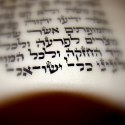
[ The following is indirectly related to this week's Torah reading (Vayikra) since it discusses how we can get a better idea of some key ideas expressed in the Hebrew text. Please skip it if you find it confusing or otherwise distracting.... ]
03.10.11 (II Adar 4, 5771) The study of the sacrificial system of ancient Israel involves understanding various theological concepts, including holiness (kedushah), purity and impurity, offerings (korbanot) and sacrifices (zevachim), the nature of atonement (kapparah), forgiveness (selichah), and so on. Part of the difficulty of such a study is discovering how the writers of the New Testament might have understood these matters in relation to the ministry of Yeshua. Scholars have attempted to link words and concepts expressed in the Torah with those of the New Testament by means of the ancient "Greek Old Testament" (i.e., the Septuagint) that was translated some 200 years before the birth of Yeshua. The assumption is that because the New Testament was written in ancient Greek, when we investigate whether it references a Torah concept (such as "atonement"), we need to first check to see how the Septuagint translated the Hebrew and then compare that with the New Testament usage. This can be a helpful approach, of course, since in some cases the New Testament writers appear to directly quote from the Septuagint.
To give you some idea of what's involved, let's consider the word "atonement." First we need to identify all instances of the Hebrew root (כ-פ-ר) in the Torah and note how the Septuagint translates these instances. Often there is not a one-to-one correspondence between the Greek and the Hebrew, so we need to discover the most commonly used Greek word used to translate the Hebrew (we also need to check to see if the Greek root is used in any other ways in the Septuagint). Second, we see if the Greek New Testament uses the same word (or root) used in the Greek Old Testament. (Note that we can also go through this process the other way around: We can look up the Greek word in the New Testament to see if it's used in the Greek Old Testament, and then compare that with the original Hebrew). To make matters a bit more complicated, with regard to New Testament usage, we often have to look for cognates of the Greek root used in the Old Testament.
Here is a simple table illustrating a bit of the process:
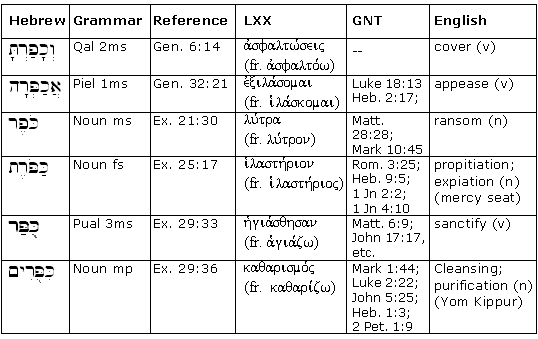 |
Of course in order to be valid, this sort of textual comparison assumes that the translators of the Torah understood Hebrew perfectly (a claim that Jewish tradition disputes), and it further implies faith that the Greek Old Testament is divinely inspired... However, it is often unclear why the Greek translators used different Greek words for Hebrew words that clearly share a common root. For example, the Hebrew verb kafar (כָּפַר) is generally translated as "to cover," "to appease," or to "wipe clean." In verses that are not connected with the sacrificial system, it can mean covering the ark of Noah with pitch (Gen. 6:14), appeasing the anger of Esau (Gen. 32:20), or turning away the displeasure of a king (Prov. 16:14). Connected to the sacrifices, kafar refers to wiping away, "blotting out," or cleansing from sin (Lev. 1:4; 4:20,26). Pertaining to Yom Kippur, the Day of Atonement, kafar is primarily used to refer to cleansing sins from the Sanctuary (mikdash), since this was regarded as the place where sins were covered until they were symbolically sent away by the scapegoat. In the New Testament, the verb most closely associated with kafar is hilaskomai (ἱλάσκομαι), usually translated as "to atone," "to propitiate," and so on in English. It occurs only twice in the New Testament (Luke 18:13; Heb. 2:17) though in the Septuagint it is used to refer to God turning away his anger in forgiveness (Exod. 32:14; Psalm 25:11).
Similarly, the Hebrew word for the cover of the Ark of the Covenant is the kapporet (כַּפּרֶת), but the Greek word used to translate this word (ἱλαστήριος) implied the idea of cleansing more than the idea of "covering." The New Testament picks up the Greek usage and refers to the kapporet as hilasmos (ἱλασμός), a word that refers to an atoning sacrifice. Paul used this word to refer to Yeshua as the "place of atonement" in Romans 3:25.
Here is one more example. The Apostle Paul wrote, "The Messiah loved us and gave himself up for us, a fragrant offering and sacrifice to God" (Eph. 5:2). The Greek word Paul used for "offering" is prosfora (προσφορά), the same word used to translate the "meal" offering (i.e. minchah: מִנְחָה) in the Septuagint. Likewise, the word Paul used for "sacrifice" is thusia (θυσία), the word used to translate a blood sacrifice (i.e., zevach: זֶבַח) in the LXX. Note further that Paul says the sacrifice of Yeshua was a "sweet-smelling savor" (ὀσμὴν εὐωδίας) to God, the same phrase (רֵיחַ־נִיחוֹחַ) used to describe whole burnt offerings upon the altar....
It's important not to lose sight of the wonder and glory of God's revealed truth, chaverim. None of this is meant to impugn the integrity of the Greek New Testament, of course, which we believe is divinely inspired. However, when we wish to better obtain a "lexicon" of Koine Greek regarding the NT Scriptures, we need to reference the ancient Greek Old Testament to see how words were used. And despite the translation of the original Hebrew concepts we find there, a great deal of work has been done over the last hundred years that can help us better understand the Hebrew texts of Scripture. The discovery of the Dead Sea Scrolls (DSS), for example, shed new light on the meaning of both Hebrew and how it was expressed in ancient Greek. Likewise, the Hebrew (and Aramaic) of the Talmud can help us find correspondences between the languages. Studying Biblical Hebrew, however, is foundational to all of this, since it is the starting point in the of the process of revelation given to the Jewish people (Rom. 3:1-2; John 4:22). In other words, you cannot rightly understand the Greek Old Testament (or much of the Greek NT, for that matter) apart from understanding the underlying Hebraic mindset, and that involves the study of the original language revealed by God from the time of the Hebrew patriarchs.
As you can see, searching out the meaning of theological concepts given in the Scriptures requires a lot of hard work and diligent study. If our aim is to "hold fast the form of sound words" (2 Tim 1:13) and to "rightly divide" (ὀρθοτομέω, lit. "cut straight") the word of truth (2 Tim. 2:15), we have little choice, however, especially since the early church chose to regard the Greek translation of the Torah as divinely inspired (and therefore largely abandoned the study of Hebrew). The LORD has promised to give us wisdom if we ask Him, and the treasures of His word certainly warrant the efforts we expend to better understand the Scriptures. Shalom for now, chaverim.
Postscript:
I took the time to write this entry primarily to give you some idea of how difficult it is to find an adequate amount of time to fully explore all the implications of verses found in a given Torah portion. It seems that as soon as I start digging into the texts it is time to move ahead to the next Torah portion, and therefore I always feel a bit behind the curve while writing every week... Please agree with my heart's prayer that God would impart wisdom to me so that I can focus on the critical issues rather than becoming bound by the constraints of the weekly Torah reading schedule. Shalom chaverim.
 |
Vayikra and Holiness

[ The following is related to this week's Torah reading (Vayikra). Please read the Torah portion to "find your place" here. ]
03.09.11 (II Adar 3, 5771) The Torah records that God's first words were "Let there be light" (i.e., yehi or: יְהִי אוֹר) and then goes on to say that "God separated (וַיַּבְדֵּל) the light from the darkness (Gen. 1:3-4). It is this "separation," or distinction, that is foundational to the concept of kedushah (קְדֻשָּׁה), or "holiness," which first appears in the Scriptures regarding the distinction between ordinary and sacred time: "God blessed the seventh day and made it holy" (יְקַדֵּשׁ) because on it God rested from all his work that he had done in creation" (Gen. 2:3).
It has been said that the theme of the Book of Leviticus is kedushah, and indeed the Hebrew root (קדשׁ) occurs over 150 times in the book. Since God is kadosh (קדשׁ), we must be kadosh in our lives as well, and this means first of all being conscious of the distinction between the sacred and the profane, the "clean" and the unclean, and so on. "You are to distinguish between the holy and the common, and between the unclean and the clean" (Lev. 10:10). Note that the word translated "distinguish" (וּלֲהַבְדִּיל) comes from the same verb used to describe how God separated the light from the darkness. We are to separate between (בֵּין) the holy and the profane, which means we need understanding (i.e., binah: בִּינָה), or the ability to discern between realms of reality... There is no other way to approach God apart from the consciousness of His infinite glory and unsurpassable worth. "I will lift up my eyes to the hills" (Psalm 121:1). As the Holy One (i.e., ha-kadosh: הַקָּדוֹשׁ), the LORD (יהוה) is utterly unique, distinct, sacred, and set apart as the only One of its kind. He alone is worthy of true worship and adoration, since He alone is utterly peerless, without rival, and stands in relation to the world as Creator, Redeemer, and Lord. To affirm that the LORD is holy is to be conscious that He is utterly sacred.
Holiness involves first of all the awareness or consciousness that there is a realm of reality "higher than" the material world (the light God created and separated from darkness was not physical), and this realm of reality is centered on Person and Will of God. A denial of this leads to the idolatrous view that material (i.e., profane) reality is absolute and therefore ascribed eternal worth. "The fear of the LORD is the beginning of wisdom." However, the LORD does not want us to merely recognize His holiness (in some abstract or intellectual sense) but calls us to be in relationship with Him, and this implies personal sanctity and separation: "You shall be holy to me, for I the LORD am holy and I have separated you (וָאַבְדִּל) from other people that you should be mine" (Lev. 20:26). The purpose of the sacrificial system was to draw near to God, and this "drawing near" required a separation from the profane world and its habitual uncleanness. The call to be holy is therefore the call to wake up and become alive to God's Presence in this world.
Personal Update: Please remember my family in your prayers, chaverim. We have experienced protracted illness and other distress lately. Thank you so much.
 |
Korban and Zevachim...

[ The following is related to this week's Torah reading (Vayikra). Please read the Torah portion to "find your place" here. ]
03.08.11 (II Adar 2, 5771) Recall that the climax of the revelation given at Sinai was the commandment to construct the Sanctuary (מקְדָּשׁ), otherwise called the Mishkan (מִשְׁכָּן) or the "Tabernacle." In other words, the redemption secured by the blood of the lamb in Egypt led directly to the revelation of the laws of the altar revealed at Sinai. Nearly half of the Book of Exodus is focused on the Mishkan, and the book concludes with the Shekhinah Glory of God revealed at Sinai filling the Holy of Holies (Exod. 40:34-35).
The Book of Leviticus (וַיִּקְרָא) links the closing paragraph of the Book of Exodus with the religious practices within the Mishkan itself, and therefore it focuses on the various forms of offerings and sacrifices (i.e., zevachim: זְבָחִים) that were integral to the worship of God. As the climax of God's revelation at Sinai, the Mishkan became the place of God's revelation (Exod. 25:22; 30:36) and the locus of corporate worship. Prophetically, the Mishkan represented the redemptive plan of God for Israel that culminated in the revelation of Yeshua the Messiah as the appointed Lamb of God (i.e., seh ha-Elohim: שֵׂה הָאֱלהִים). The Book of Leviticus is therefore central to the Torah and provides the basis for understanding the multifaceted meaning of the sacrifice of Yeshua for our reconciliation with God. The great doctrines of the Atonement (καταλλαγή), propitiation for sin (i.e., ἱλαστήριος / כַּפָּרָה), and the meaning of the Cross of the Messiah as revealed in the New Testament are all grounded in the sacrificial system revealed in the Mishkan.
In modern English the word "sacrifice" usually means an act of self-deprivation, when we give up something of value for the sake of a greater value. In the Torah, however, the idea of sacrifice has more to do with making an offering to God as a means of drawing near to Him. Positively put, such sacrifices were intended to express gratitude and joy; negatively put, they were intended to remove obstacles caused by defilement and sin. Indeed, the most common Hebrew word used to describe sacrifice is korban (קָרְבָּן), which comes from the root karov (קָרַב) meaning to "draw close" or "to come near." In the Mishkan, korbanot (קָרְבָּנוֹת) were various ritual acts that were used for the worshipper to draw near to God.
It should be noted that most of the sacrifices were intended to be enjoyed as part of a communal meal or to provide sustenance for the priests. A portion of the animal was symbolically sacrificed to God, while the remainder was eaten by the sacrificer and his guests. In this way, a sense of communion between the people and God was realized. (During the Temple period, sacrifices were accompanied with music and singing). Only the olah (עלָה), or "whole burnt offering," was entirely consumed upon the altar. There are allusions that the sacrifices represented "food" for God (Lev. 1:9; Num. 28:2), though the Scriptures repeatedly warn against understanding this in anthropomorphic terms (e.g., Psalm 50:12-13), and the prophets later decried the idea that God desired sacrifices more than He demanded ethical behavior (Amos 5:22-25; Jer. 7:22-23; 1 Sam. 15:22-23; Hos. 6:6; Isa. 1:11-20; Micah 6:6-8). According to the prophets, there can be no legitimate substitution of ritual for personal moral responsibility, and their hyperbole was intended to "get the order right" in the matter of sacrifices. "To obey is better than sacrifices..." The point of the Torah sacrifices was to provide a sense genuine communion with God and others – and that implied a heartfelt commitment to justice and the ethical imperatives of the Torah. In no way was the sacrificial system intended to "bribe" God or to ask for good luck (as was the practice of many pagan sacrificial cults).
Some of the sacrifices defined in the Torah were intended for the entire community, such as the daily offering (קָרְבַּן תָּמִיד) of a lamb and unleavened bread that were sacrificed in the morning and evening (Exod. 29:38-42). Other communal sacrifices were intended to commemorate key historical events in the life of the nation, such as the Korban Pesach (Passover sacrifice), the observance of Sabbath, and the elaborate Yom Kippur ritual. These sacrifices were mandatory for the entire nation of Israel. Still other sacrifices were individual in nature. These were either freewill (i.e., nedavah: נְדָבָה) offerings intended for fellowship or required (i.e., chovah: חוֹבָה) offerings for cleansing from defilement and sin.
It should be recalled that that the very first sacrifice of the Torah was offered by God Himself, when He slaughtered a lamb to cover the shame of Adam and Eve (Gen. 3:21). After his transgression (and expulsion from the garden), Adam built an altar and offered sacrifices to the LORD as humanity's first high priest. Adam had taught his sons about sacrifice, though unfortunately his firstborn son Cain's offering was rejected because it came from the fruit of the earth that was cursed. On the other hand, God "turned to" Abel and his offering because it was based on the original sacrifice of the lamb (Gen. 4:3-5).
When Adam later died, his son Seth (שֵׁת) became high priest in his place. When Seth later died, the priesthood went to Methuselah (מְתוּשָׁלַח) who served for centuries. Methuselah was prophesied to die seven days before the advent of the great Flood, and upon his death his grandson Noach (נחַ) was commissioned to be humanity's high priest. Noach had learned the laws of sacrifice ("clean" and "unclean") from the books of Adam and Enoch as well as from his grandfather (Gen. 8:20). After the Flood, Noach rebuilt Adam's original altar in Jerusalem (which had been destroyed earlier by wicked people of the generation of the Flood). Later, however, he was disqualified to be priest and his firstborn son Shem (שֵׁם) took his place. Shem remained in Jerusalem (i.e., Salem) and became its king and high priest (the name "Malki-Tzedek" was later ascribed to him as an honorary title). From Shem's line would come Abraham, through whom would descend the Jewish people. Each of the Hebrew patriarchs – Abraham, Isaac, and Jacob – offered sacrifices upon altars to the LORD, as did Moses before the events at Sinai. Indeed, the Korban Pesach – the sacrifice of the Passover Lamb – was the very first sacrifice given to the nation of Israel, thereby recalling the original sacrifice that covered the shame of the original exile from Eden.
Above all, Yeshua represents the fulfillment of the sacrifices of the Tabernacle system. As the Apostle Paul later wrote, "The Messiah loved us and gave himself up for us, a fragrant offering and sacrifice to God" (Eph. 5:2). The Greek word Paul used for "offering" is prosfora (προσφορά), the same word used to translate the unleavened bread offering in the LXX (i.e. minchah: מִנְחָה). Likewise, the word Paul used for "sacrifice" is thusia (θυσία), the word used to translate a blood sacrifice (i.e., zevach: זֶבַח). Note further that Paul says the sacrifice of Yeshua was a "sweet-smelling savor" (ὀσμὴν εὐωδίας) to God, the same phrase (רֵיחַ־נִיחוֹחַ) used to describe whole burnt offerings upon the altar.
Finally, the word "sacrifice" (i.e., zevach: זֶבַח) and the word "altar" (i.e., mizbe'ach: מִזְבֵּחַ) share the same Hebrew root, which may be cognate to the root zov (זוֹב) meaning "to flow." Since the purpose of sacrifice is korban (קָרְבָּן), the way we "draw close" (קָרַב) to God, the sacrifice symbolizes the outpouring of the heart before God, as it is written in Isaiah, "Their whole-burnt offerings and sacrifices for desire (וְזִבְחֵיהֶם לְרָצוֹן) shall be accepted on my altar" (Isa. 56:7).
 |
Does Your Church Celebrate Purim?

[ The holiday of Purim begins Saturday, March 19th at sundown this year... ]
03.06.11 (II Adar 1, 5771) The holiday of Purim celebrates the victory of the Jewish people over the dark forces of anti-Semitism in the world. In a sense, the entire holiday is a spoof or joke made at the expense of those who senselessly hate the Jewish people (and who therefore hate the LORD God of Israel). Purim is therefore both a time of irony and a time to celebrate how God secretly acts on behalf of His people so that they will eventually triumph over their enemies.
Throughout the centuries and in various places, many have tried to destroy the Jewish people, but none has succeeded. עַם יִשְׂרָאֵל חַי / am Yisrael chai: "The people of Israel live!" Israel is God's "super sign" that He is faithful to His covenant promises (Jer. 31:35-37), and since God keeps His promises to Israel, we likewise can trust that God's sovereign hand works "all things together for good" -- even if at times these things appear quite desperate (Rom. 8:28). Because the LORD God of Israel is Faithful and True, Purim is a surely a holiday that followers of Yeshua should celebrate (Rom. 11:1). If your church group doesn't celebrate this holiday, ask your pastor there why not...
This year Purim begins Saturday, March 19th at sundown, that is, on the 14th of Adar, the day after Haman's roll of the dice indicated that the 13th of Adar was most "propitious" date to exterminate the Jews of Persia. Note that Purim is celebrated the day after since it was at that time that the Jews experienced the joy of their deliverance (in Israel, Purim is observed a day later still (i.e., on Adar 15th) and is called Shushan Purim).
 |
Parashat Vayikra - ויקרא

[ The following is related to this week's Torah reading (Vayikra). Please read the Torah portion to "find your place" here. Note that the Book of Leviticus is always read during the season of Passover. The life is in the blood - of Yeshua the Lamb of God! ]
03.06.11 (II Adar 1, 5771) The Torah portion for this week is Vayikra ("and He called"), the very first section from the Book of Leviticus. Vayikra is sometimes called the "Book of Sacrifices" since it deals largely with the various offerings brought to the LORD for sacrificial purposes in the Mishkan (Tabernacle). Over 40 percent of all of the Torah's commandments are found in this central book of the Scriptures.
It is an age-old Jewish custom to begin teaching young children the Torah beginning with Vayikra because they, like the sacrifices themselves, are considered pure. The sage known as the Kli Yakar states that this is one of the reasons why the Aleph (א) in Vayikra (ויקרא) is written very small in the Torah scroll. Let these teachings be the beginning, like the letter Aleph, which is the beginning of the Aleph-Bet. When we humble ourselves as little children, God will reveal His truth to us.

Other sages reasoned that Moses' humility (i.e., anavah: עֲנָוָה) was such that he first waited for the LORD to call him into the Mishkan (Tabernacle), despite the fact that God had previously granted him full access to His Presence. The scroll begins with an undersized Aleph as a scribal token of Moses' humility. (The Zohar states that the undersized Aleph signifies that the Tabernacle was not fully complete without the engagement of Israel.) The "spirit of the little Aleph" means that we should always exercise derech eretz -- reverence and politeness -- before the Divine Presence.
The Korban Principle
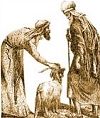
The purpose of the sacrifices was likewise to imbue a sense of humility. At each stage of the offering, the worshipper would see how the animal was slaughtered, dismembered, its blood sprinkled, and its fat burned on the altar -- all for his sake... This is the "korban" principle of "life-for-life." The guilty person would lean his hands upon the head of the animal (semichah) and then say confession (viduy): "I deserve to die instead of this innocent animal, but the LORD mercifully accepts the death of this innocent one in my stead." The worshipper would understand that were it not for chasdei Adonai (חֲסְדֵי יהוה) - the love of the LORD - this should have been his fate. When the LORD saw the shed blood and ascending smoke of the sacrifice, He forgave the sinner based on his faith and teshuvah (repentance). The entire sacrificial system was therefore predicated on God's love that foreshadowed the ultimate sacrifice of Yeshua, the Son of God.
Some of the sages note that the word korban (קָרְבָּן) is often translated "sacrifice" or "offering" (the Greek LXX uses the word δῶρον, "gift"), though it derives from a root (קָרַב) that means to "draw close" or "to come near." Offering a sacrifice in the Tabernacle (and later, at the Temple) was therefore a means of coming close to the LORD in repentance and humility...
In ancient Israel there were three "classes" within the structure of Jewish society: the Kohen, the Levite and the Israelite. The Kohen was a physical descendant of Aaron who functioned as a priest of Israel. His primary role was to offer sacrifices on behalf of other Jews (his cousin, the Levite, served as his assistant, helping to maintain the Mishkan, carry vessels, and so on). Only the Kohanim could perform avodah (priestly service) even though originally the firstborn of each family was to function as a priest of Israel. On Yom Kippur, only the High Priest of Israel could offer sacrifice on behalf of all the Jews...
The sacrifice of Yeshua as the Kohen Gadol of the better covenant was given by God the Father on behalf of all those who put their trust in his Son. The Cross of Yeshua represented the kapporet ("mercy seat") of the New Covenant -- and it was there He shed his blood for our everlasting reconciliation to God. We can all draw near to God and be close to Him because of the Korban of Yeshua... Moreoever, when the sacrifice was complete (and Yeshua died), the veil of the Temple -- the parochet that separated the Holy of Holies from the Holy Place -- was rent asunder, thereby granting access to the "throne of grace" (θρόνος τῆς χάριτος) (Heb. 4:16). Because of the High Priestly work of Yeshua, Levitical mediators are no longer necessary (1 Tim. 2:5), and all who trust in the Messiah are called "spiritual kohanim" (1 Pet. 2:5-9). Followers of Yeshua have an altar whereof those who attempt to serve in the older system are unable to eat (Heb. 13:10).
Note that we are part of the priesthood after the order of Malki-Tzedek (מַלְכִּי־צֶדֶק), the "King of Righteousness." Yeshua is Adonai Tzidkenu - יְהוָה צִדְקֵנו - the LORD our Righteousness. We do not account ourselves worthy based on our personal merit, but solely on account of the finished avodah of Yeshua our LORD. Since we have access to the "throne of grace," and the word grace (χαρις) is related to the word joy (χαρα), we are called to offer sacrifices of praise. We are called to be Korban Chai -- Living Sacrifices -- on behalf of the ongoing ministry of our Messiah who urges all people to repent and draw near to the Father through Him. Because of the grace of God given to us in Yeshua, we are "briah chadashah" (בְּרִיאָה חֲדָשָׁה) - new creations in the Messiah!
A Note about ELS Sequences
Some Bible teachers (such as Chuck Missler and others) claim that the Scriptures contain various "codes" that reveal its supernatural origin. For example, Missler claims that the word Torah (תּוֹרָה) is found in "Equidistant Letter Sequences" (ELS) of 50 (i.e., 49 spaces between letters) in both Genesis and Exodus. He further claims the word is spelled backwards (i.e., הרות) in both Numbers and Deuteronomy using the same 50 letter sequence. In the Book of Leviticus, this pattern does not appear, though the sacred Name YHVH (יהוה) is discovered using ELS 8 (i.e., 7 spaces between letters). In this way he attempts to argue that the Torah always points to the Name of God, or that the Book of Leviticus is the center of the Torah...
Now while this is somewhat interesting, there are problems with this approach. First of all, while it is true that the word תורה can be found at ELS 50 at the beginning of Genesis and Exodus, and while it is also true that the word הרות appears using ELS 50 in Numbers, the sequence does not appear in Deuteronomy until chapter 5. Moreover, these patterns do not recur throughout the books but simply occur one time (i.e., it is not true that the word "Torah" can be discovered by counting every 50 letters over and over again). Furthermore, the letter combinations for תורה and הרות can be found at 50 ELS in other parts of the Bible, not just in the first five books, so the argument that they uniquely "point" to the Book of Leviticus as the center of the Torah is suspect. In other words, the frequencies of these letter combinations at ELS 50 (or in other increments) is simply too high to make a case that this indicates supernatural codes embedded within the texts. Teachers who promote these sorts of ideas as a "proof" of the Bible's authority are therefore using bad arguments to make rather sensationalized claims. We do not need to look for "Bible Codes" to find the truth, chaverim, we need the Holy Spirit and the desire to live according to the truth...
 |
Be Not Afraid...

03.04.11 (I Adar 28, 5771) Most of us understand that loving God is our essential obligation, the end or "goal" of all the other commandments, the very reason why God has spoken and why we exist. Yeshua plainly taught that this was the point of "the law and the prophets," the rest being commentary (Matt. 7:12, Matt. 22:36-40). However, while love is the greatest commandment, you might be surprised to learn that the most frequent commandment is simply al-tirah, "Be not afraid." Over and over again in the Scriptures we hear the LORD saying to those who trust in Him, al-tirah, "be not afraid."
אַל־תִּירָא כִּי עִמְּךָ־אָנִי אַל־תִּשְׁתָּע כִּי־אֲנִי אֱלהֶיךָ
אִמַּצְתִּיךָ אַף־עֲזַרְתִּיךָ אַף־תְּמַכְתִּיךָ בִּימִין צִדְקִי
al ti·ra ki im·me·kha a·ni; al tish·ta ki a·ni E·lo·he·kha
im·matz·ti·kha af a·zar·ti·kha, af te·makh·ti·kha bi·min tzid·ki

"Fear not, for I am with you; be not dismayed, for I am your God;
I will strengthen you, I will help you, I will uphold you with my righteous right hand."
(Isaiah 41:10)

Download Study Card
Of course this doesn't mean that we should pretend that evil doesn't exist or that there's no real danger in this world. No, the Scriptures are clear that such things are indeed real. There are spiritual enemies in the world and we are engaged in a genuine spiritual war. The devil walks about as a roaring lion, seeking whom he may devour (1 Pet. 5:8). But despite these things – or rather, in light of them – al-tirah, "Be not afraid."
"There is no fear in perfect love," as the Apostle John wrote (1 John 4:18). If we love God because He first loved us (1 John 4:19), then we find courage because of the heart He imparts to us. This was part of the very mission of the Messiah, to "deliver all those who through fear of death were subject to lifelong slavery" (Heb. 2:15). True, we are to fear the LORD, but this does not denote a cringing terror of God's judgment but rather a reverential awe as He daily condescends to be involved in our lives.
A midrash says that the Ten Plagues were needed – not to convince Pharaoh that the LORD was God – but rather to convince the children of Israel of God's love! After all, without faith in that, Israel would never have ventured to leave Egypt. The same could be said of the greater Exodus given through the Cross: the suffering of Yeshua was not only payment for sin but also the means to be recreated in God's love.
Sometimes God reveals His care for us in spectacular ways, but He always provides "hidden miracles" that uphold us every day. God didn't just create the universe and then remove Himself from its care: Yeshua is sustaining all things by the Word of His power at all times (Col. 1:17). Living in the light of God's Presence reveals the daily bread that comes from Heaven, but those who refuse the truth find no lasting sustenance for the world to come... We all must believe that God is making miracles for us to live and grow in this age; otherwise we are living in fear.
Nachman of Breslov once said that "The whole earth is a very narrow bridge, and the point of life is never to be afraid." Likewise we understand Yeshua to be the Bridge to the Father, the narrow way of passage that leads to life. He calls out to us in the storm of this world, "Take heart. It is I; be not afraid" (Matt. 14:27). When Peter answered the call and attempted to walk across the stormy waters, he lost courage and began to sink, but Yeshua immediately reached out his hand and took hold of him, saying, "O you of little faith, why did you doubt (lit., think twice)?"
We must be careful not to let the light in us become darkness (Luke 11:35). The love and acceptance of God is the answer to our fear, not the thought of being judged by Him or attempting to merit his favor through religion. God's love is our hope, and this hope gives us courage to persevere the storms of the day...
May God help us to hear Him saying, al-tirah, "Be not afraid."
 |
Table Talk for Parashat Pekudei
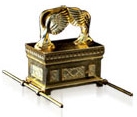
[ The following is related to this week's Torah reading (Pekudei). Please read the Torah portion to "find your place" here. ]
03.03.11 (I Adar 27, 5771) Today I wrote a Shabbat "Table Talk" for this week's Torah portion (Pekudei), which is the final portion of the Book of Exodus. Like other Table Talk guides, I first provide a brief synopsis of the reading and then ask some discussion questions. I hope you find it helpful, chaverim. You can download the page here.
Jewish tradition states that this was Moses' blessing upon the people of Israel after the work for the Mishkan was completed (Exod. 39:43):
וִיהִי נעַם אֲדנָי אֱלהֵינוּ עָלֵינוּ
וּמַעֲשֵׂה יָדֵינוּ כּוֹנְנָה עָלֵינוּ
וּמַעֲשֵׂה יָדֵינוּ כּוֹנְנֵהוּ
ye·hi · no·am · Adonai · E·lo·hei·nu · a·lei·nu,
u·ma·a·seh · ya·dei·nu · ko·ne·nah · a·lei·nu,
u·ma·a·seh · ya·dei·nu · ko·ne·nei·hu

"May the beauty of the Lord our God be upon us,
and establish the work of our hands upon us;
yea, establish the work of our hands!"
(Psalm 90:17)

Download Study Card
Please understand that there is a lot of spiritual warfare that attends this ministry, and I sincerely appeal to you to remember us in your prayers. Every day we face attack from the enemy of our souls, and we appeal for God's hand of protection to cover us in the midst of the battles. Thank you so much.
יְהוָה עז לְעַמּוֹ יִתֵּן
יְהוָה יְבָרֵךְ אֶת־עַמּוֹ בַשָּׁלוֹם
Adonai oz le·am·mo yit·ten,
Adonai ye·va·rekh et am·mo va·sha·lom

"The LORD will give strength to his people;
The LORD will bless his people with peace" (Psalm 29:11)

Download Study Card
Choosing to Belong...
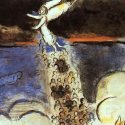
[ This week's Torah reading (Pekudei) concludes the Book of Exodus... Chazak chazak venitchazek: "Be strong! Be strong! And may we be strengthened!" ]
03.01.11 (I Adar 25, 5771) The theme of the Book of Exodus essentially turns on two great events, namely, the deliverance of the Israelites from their bondage in Egypt (yetzi'at Mitzraim) and the subsequent revelation given at Sinai (mattan Torah). Both of these events, however, are grounded in the deeper theme of God's faithful love combined with the need for blood atonement. With regard to the former, the blood of the Passover lamb was required to cause death to "pass over" the houses of the Israelites; with regard to the latter, the sacrificial system (i.e., the Mishkan) was required to draw near to God.
Jewish tradition tends to regard the giving of the law at Sinai to be the goal of the entire redemptive process, a sort of "return from Exile" to the full stature of God's chosen people. Some of the sages have taken this a step further by saying that God created the very universe so that Israel would accept the law. Such traditions, it should be understood, derive more from Jewish rabbinical thinking codified after the destruction of the Second Temple than from the narrative presented in the written Torah itself, since is clear that the climax of the revelation at Sinai was to impart the pattern of the Mishkan to Moses. In other words, the goal of revelation was not primarily to impart a set of moral or social laws, but rather to accommodate the Divine Presence in the midst of the people. This is not to suggest that the various laws and decrees given to Israel were unimportant, of course, since they reflected the holy character and moral will of God. Nonetheless, it is without question that the Torah was revealed concurrently with the revelation of the Sanctuary itself, and the two cannot be separated apart from "special pleading" and the suppression of the revelation given in the Torah itself... The meticulous account of the Mishkan is given twice in the Torah to emphasize its importance to God. This further explains why Leviticus is the central book of the Torah of Moses. (For more on this, see "The Eight Aliyot of Moses.")
As we consider these things, however, it is important to realize that underlying the events surrounding deliverance and revelation is something even more fundamental, namely, the great theme of faith (אֱמוּנָה). This theme is our response to God's redemptive love. God's love is the question, and our response - our teshuvah - is the answer. The great command is always to "Choose life!" We must chose to turn away from the darkness to behold the Light... Jewish tradition states there were many Jews who perished in Egypt during the Plague of Darkness because they refused to believe in God's love. Likewise, the revelation at Sinai failed to transform the hearts of many Jews because they despaired of finding hope...
As glorious as the redemption and revelation was, then, there was something even more foundational that gave "inward life" to God's gracious intervention. You must first believe that God loves you and regards you as worthy of His love; you must "accept that you are accepted." It is your faith that brings you near... This is the "Cinderella Story" of Exodus.
The themes of Exodus will mean little to you unless you identify with the journey of the people, and that implies that you reckon yourself as worth saving... You must see yourself as the recipient of divine affection and love. After all, without this as a first step, how will you make the rest of the journey? This is similar to the very First Commandment revealed at Sinai: "I am the LORD your God, who brought you out of the land of Egypt..." Notice that the statement, "I am the LORD your God" (אָנכִי יְהוָה אֱלהֶיךָ) was uttered in the second person singular, rather than in the plural. In other words, you (personally) must be willing to accept the love of the LORD into your heart, since the rest of the Torah is merely commentary to this step of faith. Therefore the Book of Exodus is called Shemot (שְׁמוֹת), "names," because it sees every person as worthy of God's redeeming love and revelation. "For God so loved the world..." (John 3:16).
Those who directly experienced God's deliverance in Egypt first of all believed they were redeemable people. Before anything else they made a decision to receive hope within their hearts. The blood of the original Passover was a sign of faith. We must begin here. This is the start of the journey. We step out by faith, leaving behind the familiar - including the familiarity of our sin and shame - and venture out into the unknown. We venture out in hope, because we trust in the love and promises of God.
The journey of faith is marked with testing, of course. Being called out of the world leads you into the desert places. Faith is not something static, like a church creed or theology handbook. There are stony places, dangers, and difficulties that attend the way. We move out from "walled cities" into tents, traveling as "strangers and sojourners" on our way to a promised heavenly city. Therefore the Scriptures state that "by faith Abraham went to live in the land of promise, as in a foreign land, living in tents with Isaac and Jacob, heirs with him of the same promise. For he was looking forward to the city that has foundations, whose designer and builder is God" (Heb. 11:9-10). The way back home is the same for all who "cross over" from this world to the next. It is the way of hope, trust, and surrender.
The story of Exodus is not the story of "other people." You must choose to belong. Your faith draws you near. That is why the sages teach: b'chol dor vador - in each and every generation an individual should look upon him or herself as if he or she (personally) had left Egypt. It's not enough to recall, in some abstract sense, the deliverance of the Jewish people in ancient Egypt, but each Jew is responsible to personally view Passover as a time to commemorate their own personal deliverance from the bondage of Pharaoh. The same must be said regarding Shavuot. Each person should consider himself as having personally received revelation at Sinai. The altar of the Mishkan was set up for you to draw near to God - you, not some people who lived long ago... This is why non-Jews who turn to the God of Israel by putting their trust in the Messiah are regarded equal members in the covenants and promises given to ethnic Israel. It is a brit milah (בְּרִית מִילָה) - literally, a "covenant of the word" - that makes us partakers of the covenantal blessings given to Abraham (Eph. 2:12-19; Gal. 3:7; Col. 2:11, etc.)...
The narratives of the Book of Exodus, like other narratives of the Torah, often function as parables for us. "The deeds of the fathers are signs for the children." Signs of what? Of the coming Messiah, as Yeshua Himself attested and the apostles likewise affirmed (John 5:46; Luke 24:27;44; Matt. 13:52; 2 Tim. 3:14-17). The Mishkan itself was a metaphor of God's redemption given in Yeshua. The Mercy Seat (kapporet) represented the Throne of God (Heb. 4:16; 2 Ki. 19:15) where propitiation for our sins was made (Rom. 3:25). Indeed, the word Mishkan (מִשְׁכָּן) is related to the word mishken (מִשְׁכֵּן), "collateral on a loan." The Tabernacle functioned as a "loan" to Israel until the Messiah came to establish the true Temple by means of His atoning sacrifice (Gal. 3:19). The law is called a "schoolmaster" meant to lead to the Messiah and His Kingdom rule (Gal. 3:23-26). The glory of the Torah of Moses was destined to fade away (2 Cor. 3:3-11), just as its ritual center (i.e., the Tabernacle/Temple) was a shadow (σκιά) to be replaced by the greater priesthood of Malki-Tzedek (Heb. 10:1; 13:10). "Now we are released from the law, having died to that which held us captive, so that we serve in the new way of the Spirit and not in the old way of the written code (Rom. 7:6). Yeshua is the Goal and the "Goel" (i.e., גּאֵל, Redeemer) from the curse of the law... "For the law made nothing perfect, but on the other hand, a better hope is introduced, and that is how we draw near to God" (Heb. 7:19). When the veil is taken away, Yeshua appears on every page of Scripture... (For more on this, see "Why then the Law?," and "Paul's Midrash of the Veil").
Outside of the Mishkan, beyond the outer court, are the raw, "natural" experiences of life. This is the realm of the carnal flesh and the "dust to dust, ashes to ashes" despair of olam hazeh. Spiritual life is found when you come in through the gate. You must understand that the gate is there for you to pass through.... The cross of Yeshua is the altar where He died for you, personally, for your atonement with the Father. His blood was presented between the outstretched wings of the cherubim so that you could come before God "panim el panim," that is, personally, "as a man speaks to his friend" (Heb. 4:16). Your faith bridges the gap between the "Holy of Holies" of the Cross and the sanctuary of your heart...
 |
|





































